The document provides a detailed overview of auto-encoders, a fundamental building block in deep learning, covering concepts such as hierarchical and sparse representations, and the distinction between supervised and unsupervised learning. It encompasses a tutorial on auto-encoder architecture, inference, learning techniques, and applications, particularly illustrated through handwritten digit recognition and text processing. Additionally, it discusses the importance of encoding and decoding procedures, including energy functions and loss minimization strategies in the context of sparse coding.
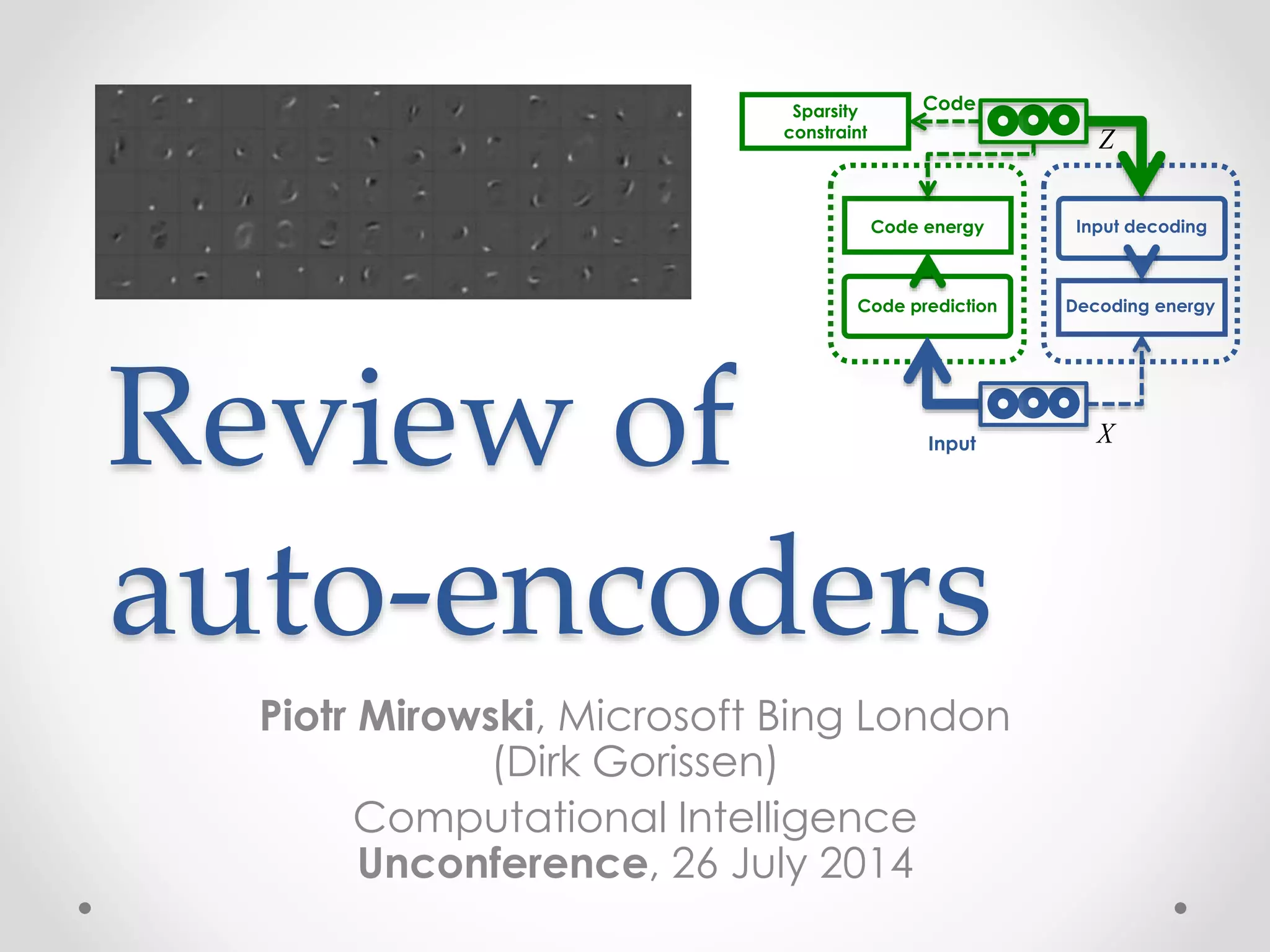
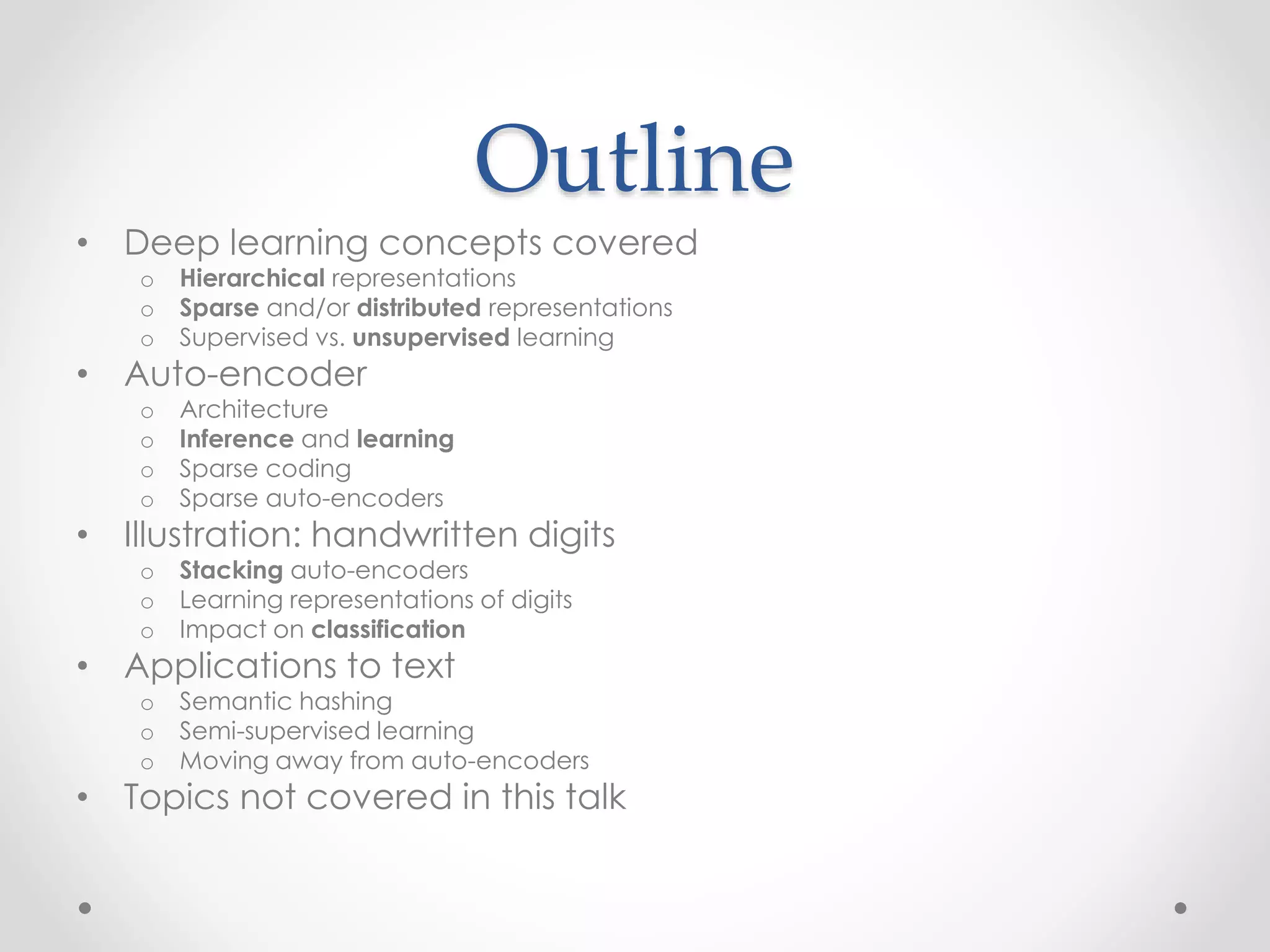
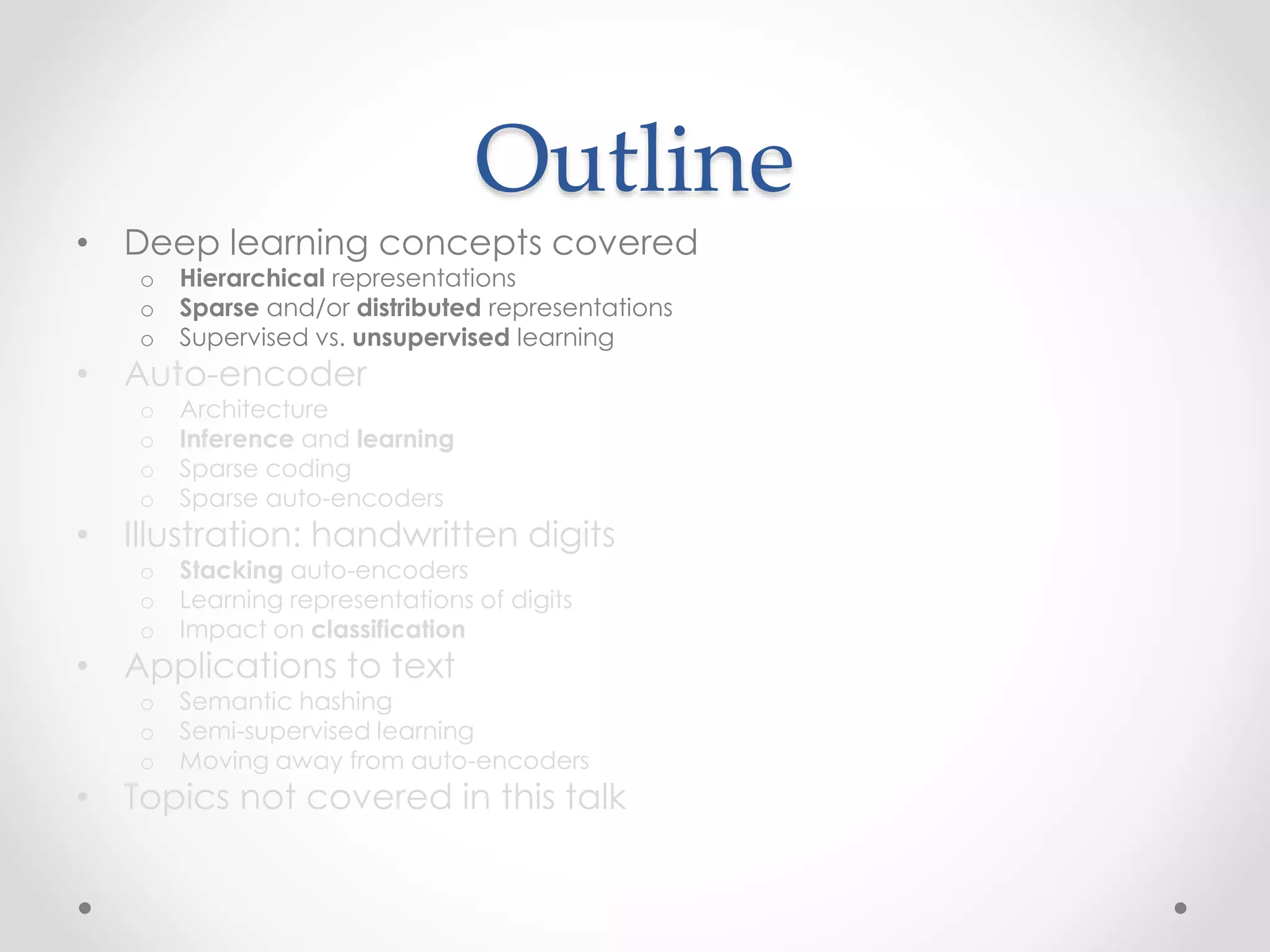
![Hierarchical
representations
“Deep learning methods aim at
learning feature hierarchies
with features from higher levels
of the hierarchy formed by the
composition of lower level
features.
Automatically learning features
at multiple levels of abstraction
allows a system
to learn complex functions
mapping the input to the output
directly from data,
without depending completely
on human-crafted features.”
— Yoshua Bengio
[Bengio, “On the expressive power of deep architectures”, Talk at ALT, 2011]
[Bengio, Learning Deep Architectures for AI, 2009]](https://image.slidesharecdn.com/piotrmirowskiciunconf2014reviewautoencoders-140820024912-phpapp02/75/Piotr-Mirowski-Review-Autoencoders-Deep-Learning-CIUUK14-4-2048.jpg)
![Sparse and/or distributed
representations
Example on MNIST handwritten digits
An image of size 28x28 pixels can be represented
using a small combination of codes from a basis set.
[Ranzato, Poultney, Chopra & LeCun, “Efficient Learning of Sparse Representations with an Energy-Based Model ”, NIPS, 2006;
Ranzato, Boureau & LeCun, “Sparse Feature Learning for Deep Belief Networks ”, NIPS, 2007]
Biological motivation: V1 visual cortex](https://image.slidesharecdn.com/piotrmirowskiciunconf2014reviewautoencoders-140820024912-phpapp02/75/Piotr-Mirowski-Review-Autoencoders-Deep-Learning-CIUUK14-5-2048.jpg)
![Sparse and/or distributed
representations
Example on MNIST handwritten digits
An image of size 28x28 pixels can be represented
using a small combination of codes from a basis set.
At the end of this talk, you should know how to learn that basis set
and how to infer the codes, in a 2-layer auto-encoder architecture.
Matlab/Octave code and the MNIST dataset will be provided.
[Ranzato, Poultney, Chopra & LeCun, “Efficient Learning of Sparse Representations with an Energy-Based Model ”, NIPS, 2006;
Ranzato, Boureau & LeCun, “Sparse Feature Learning for Deep Belief Networks ”, NIPS, 2007]
Biological motivation: V1 visual cortex (backup slides)](https://image.slidesharecdn.com/piotrmirowskiciunconf2014reviewautoencoders-140820024912-phpapp02/75/Piotr-Mirowski-Review-Autoencoders-Deep-Learning-CIUUK14-6-2048.jpg)
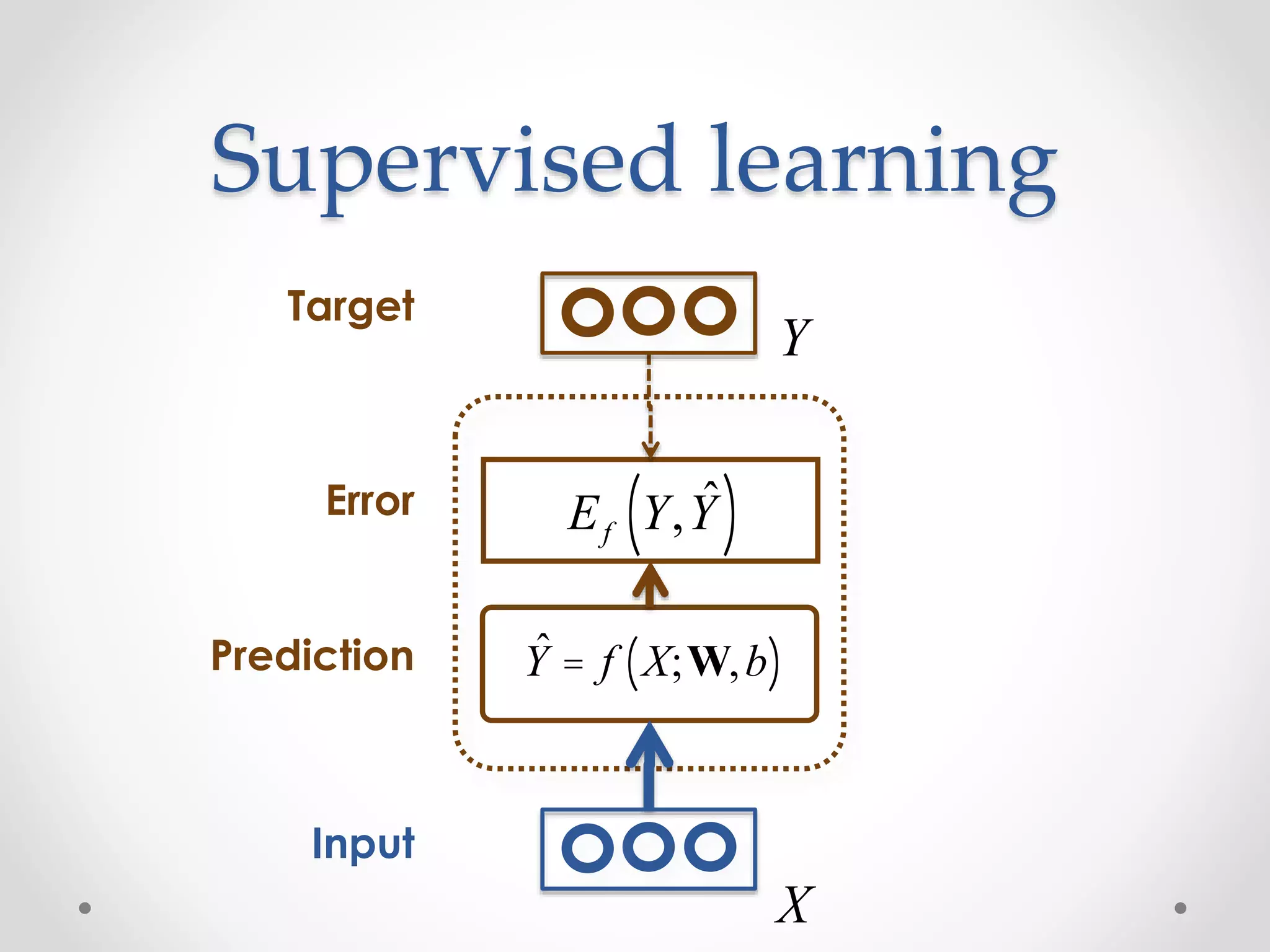
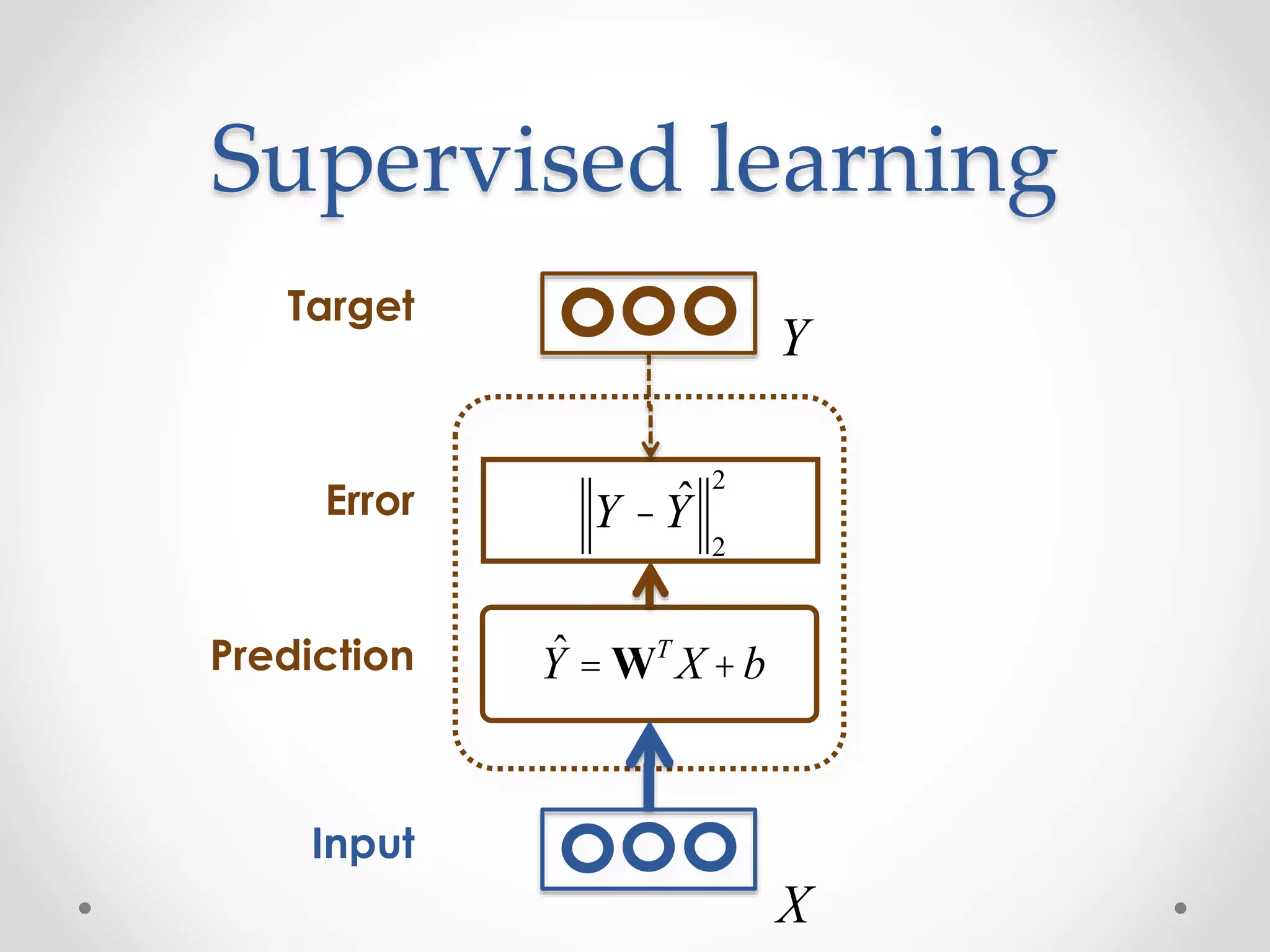
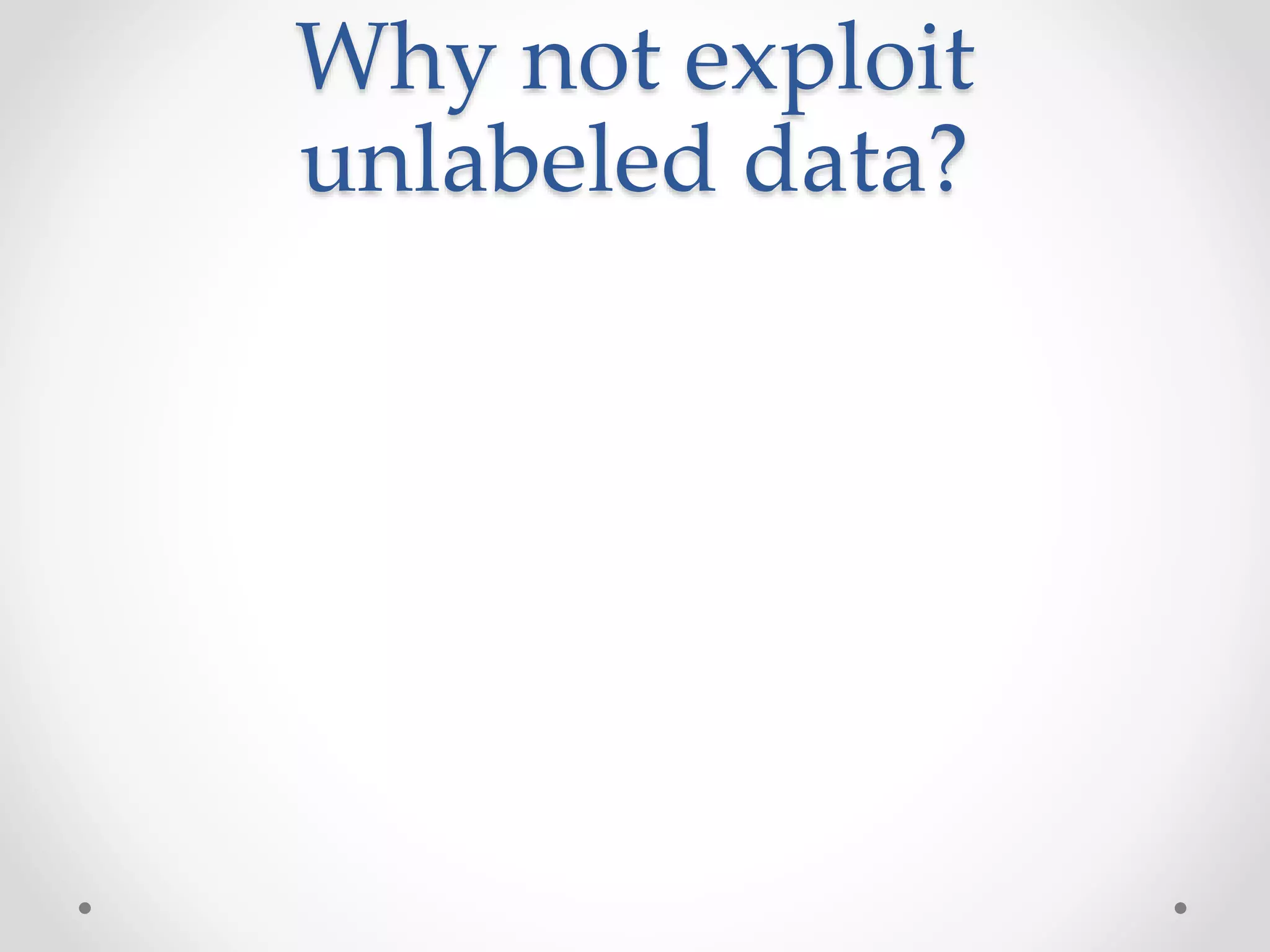
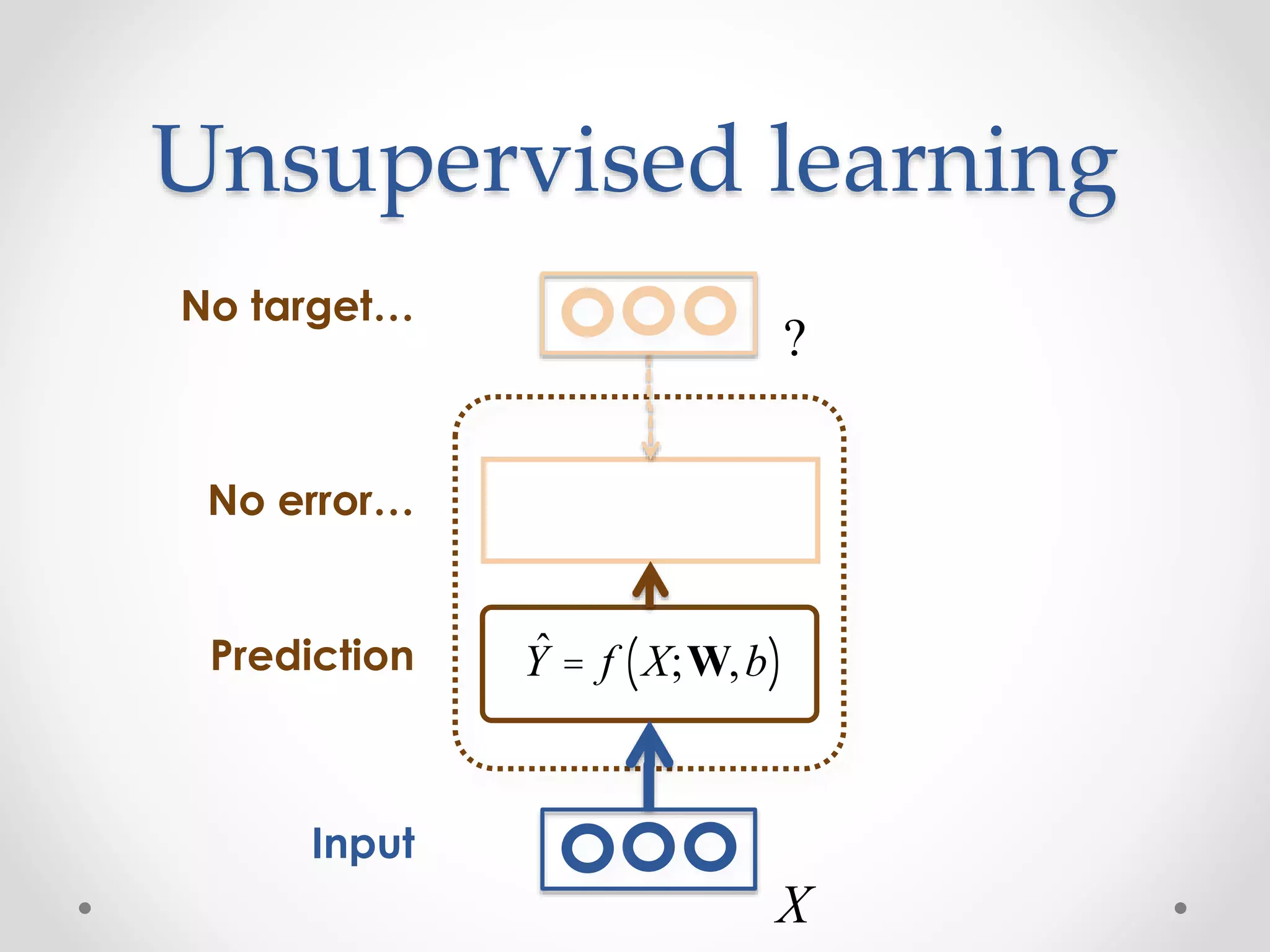
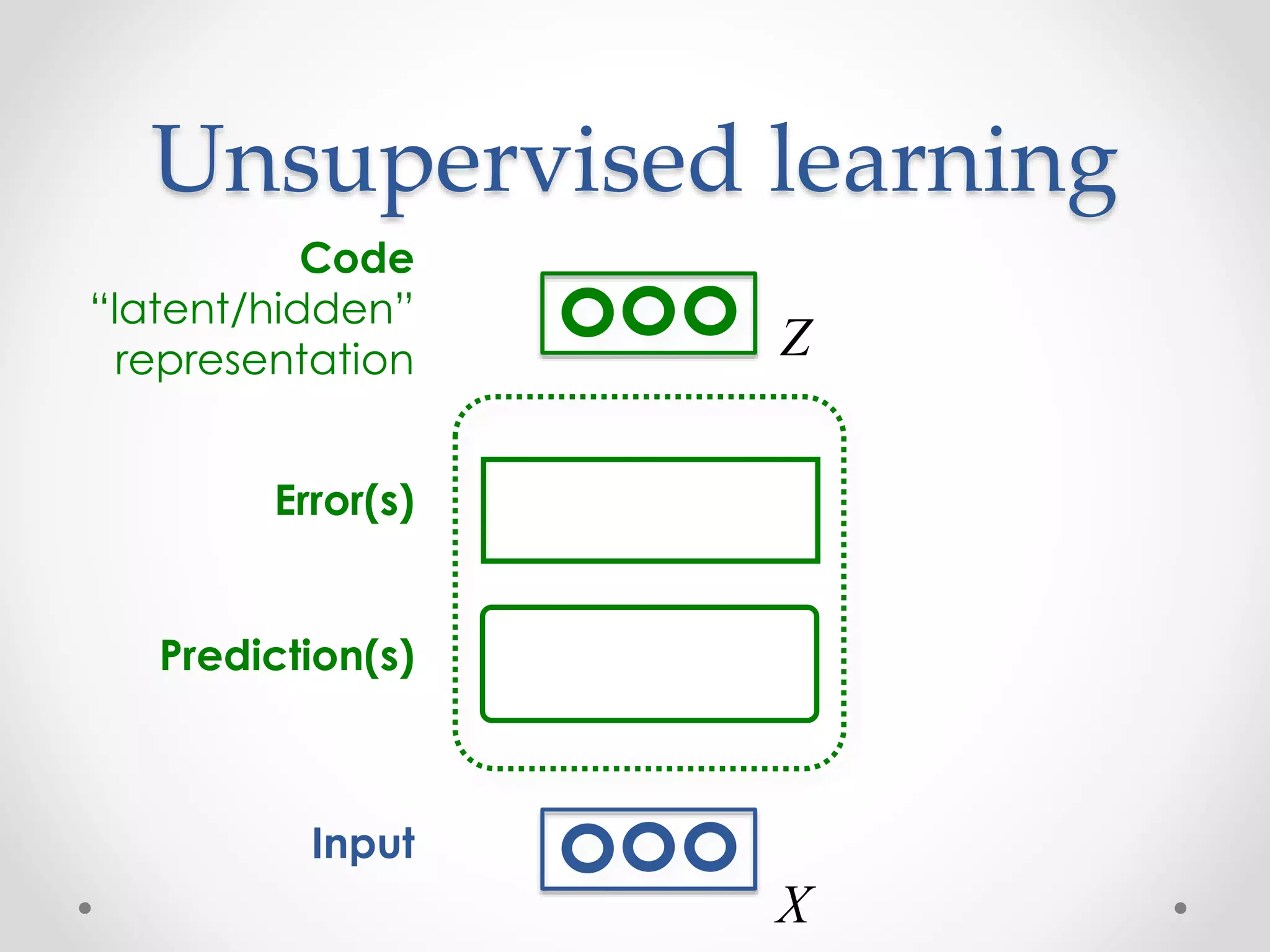
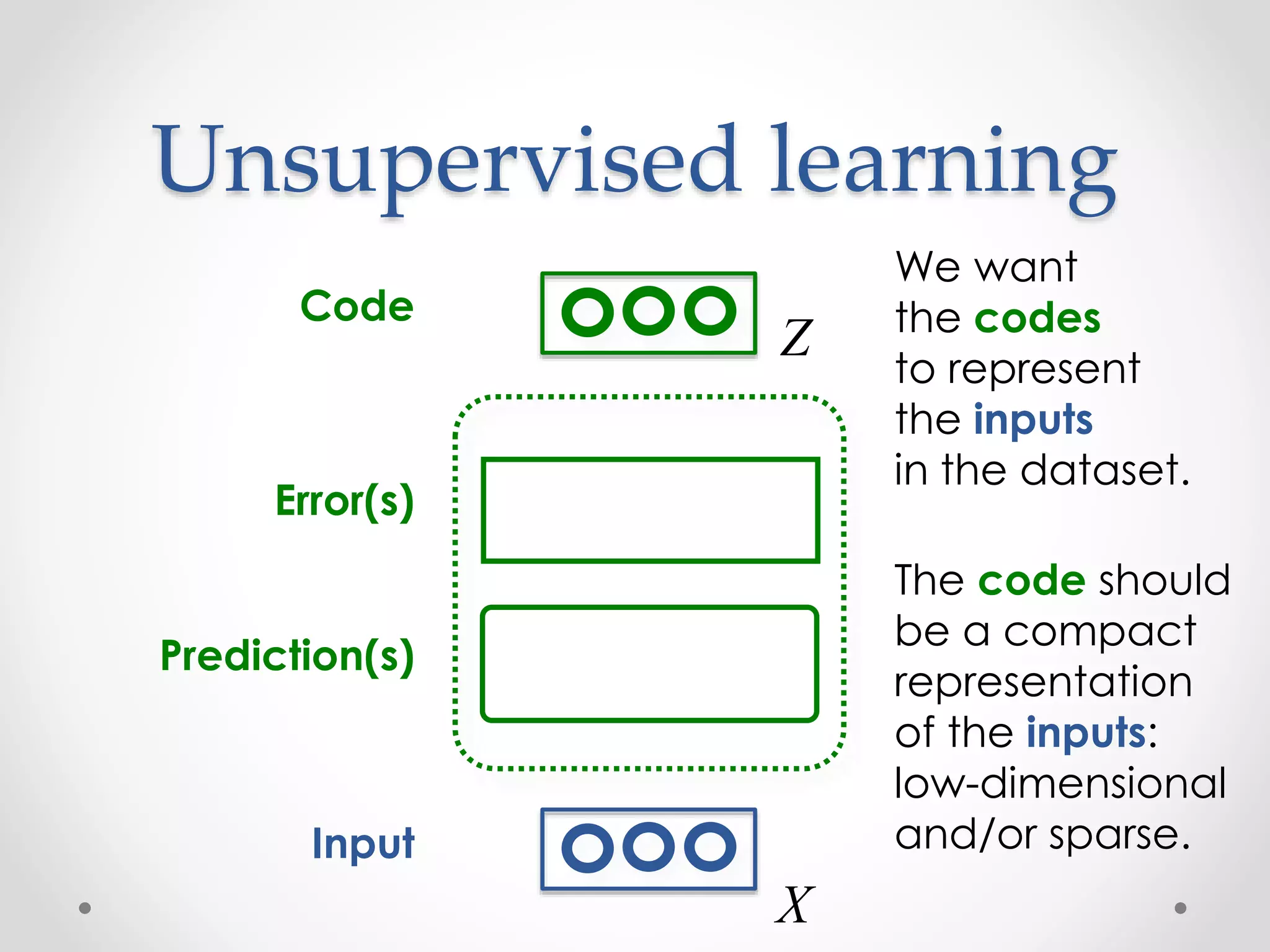
![Examples of
unsupervised learning
• Linear decomposition of the inputs:
o Principal Component Analysis and Singular Value Decomposition
o Independent Component Analysis [Bell & Sejnowski, 1995]
o Sparse coding [Olshausen & Field, 1997]
o …
• Fitting a distribution to the inputs:
o Mixtures of Gaussians
o Use of Expectation-Maximization algorithm [Dempster et al, 1977]
o …
• For text or discrete data:
o Latent Semantic Indexing [Deerwester et al, 1990]
o Probabilistic Latent Semantic Indexing [Hofmann et al, 1999]
o Latent Dirichlet Allocation [Blei et al, 2003]
o Semantic Hashing
o …](https://image.slidesharecdn.com/piotrmirowskiciunconf2014reviewautoencoders-140820024912-phpapp02/75/Piotr-Mirowski-Review-Autoencoders-Deep-Learning-CIUUK14-13-2048.jpg)
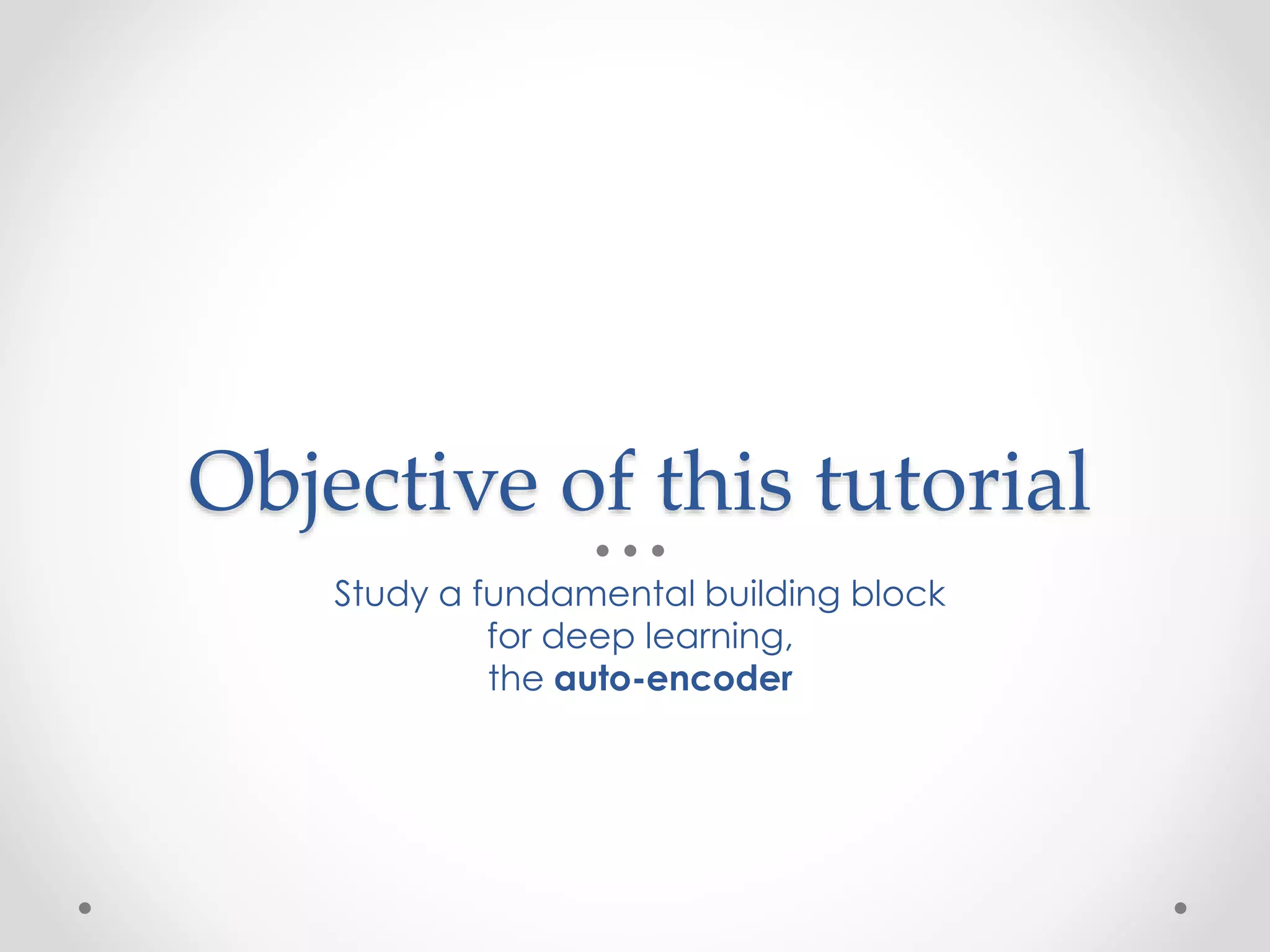
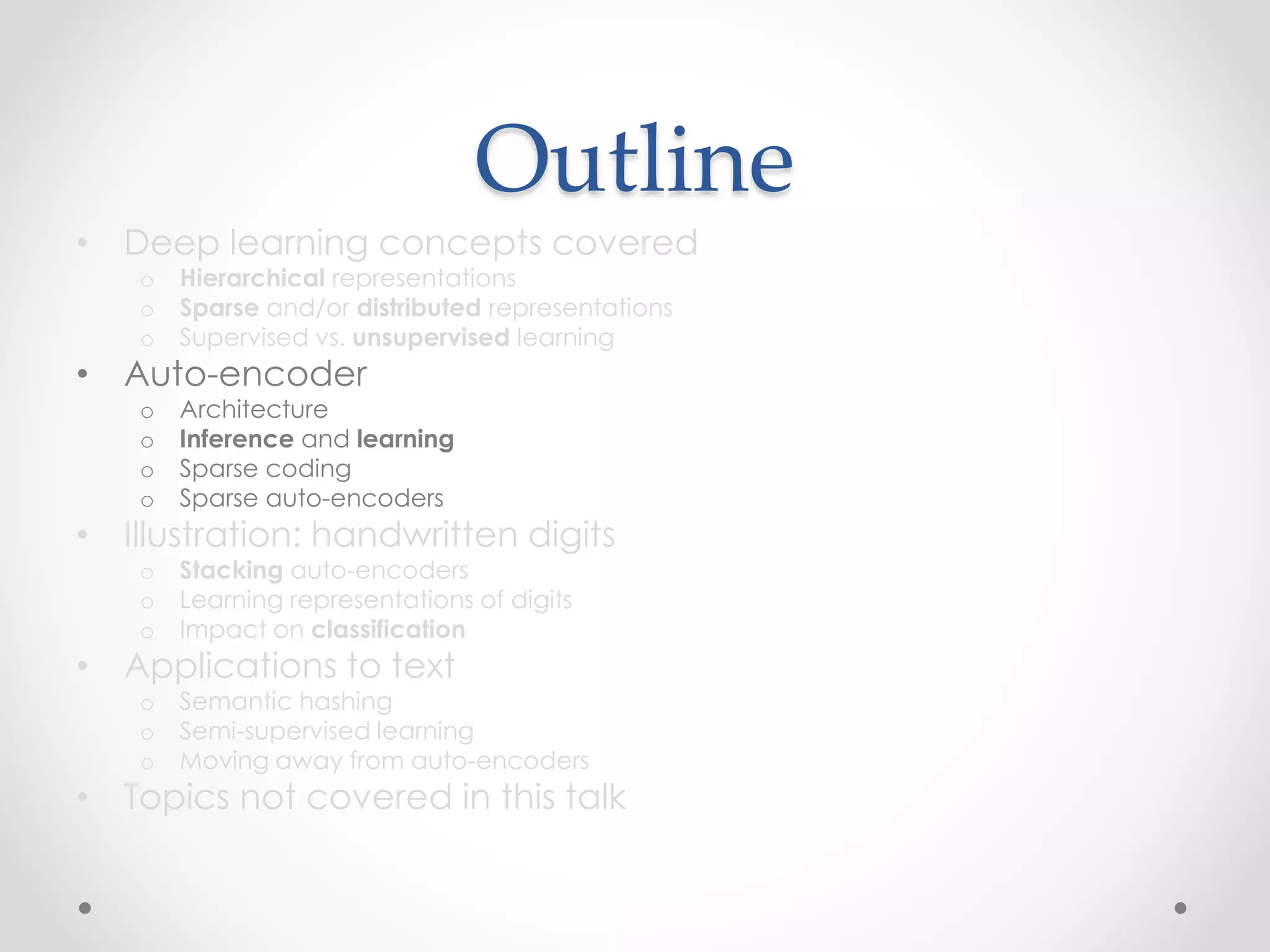
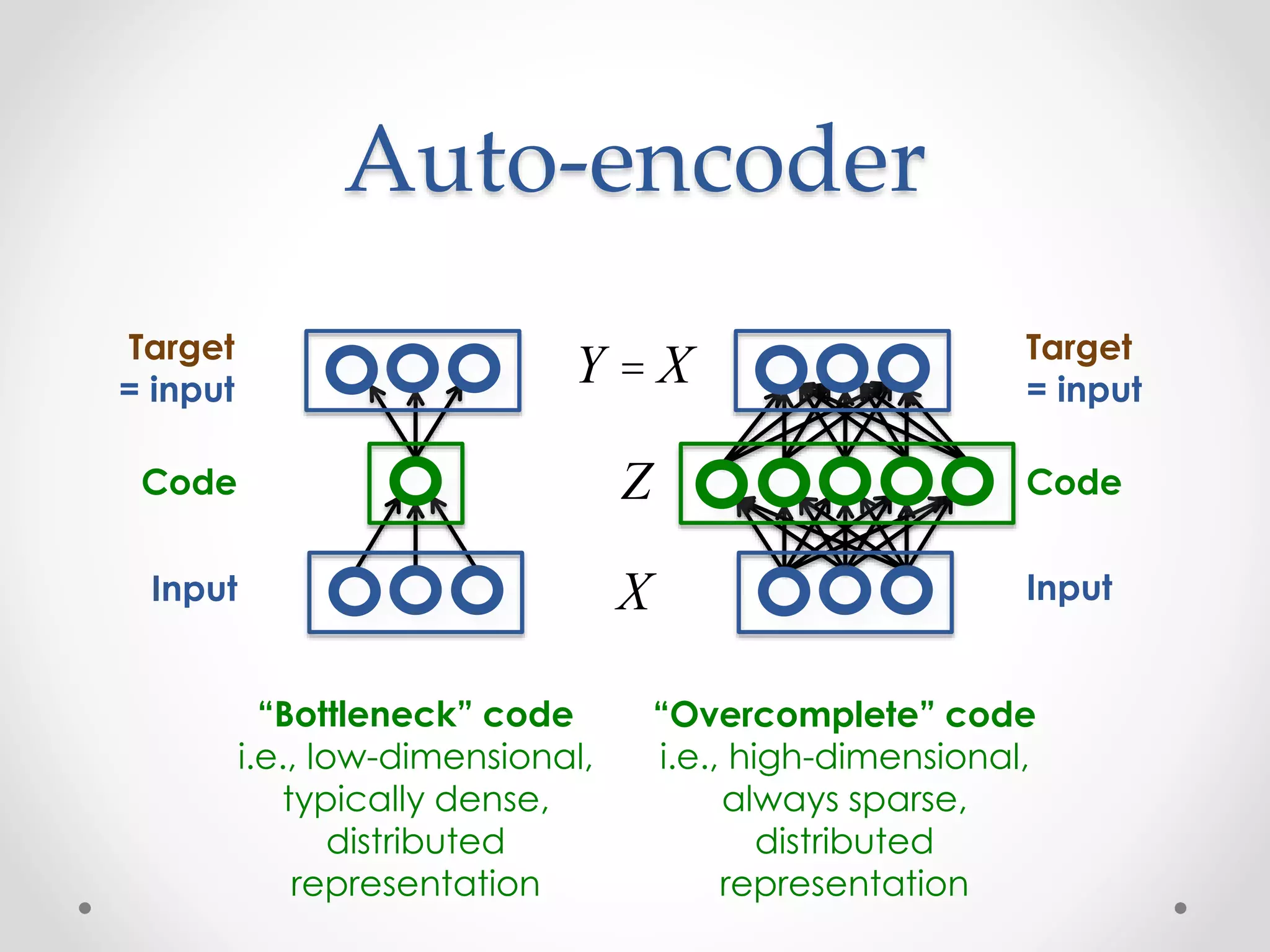
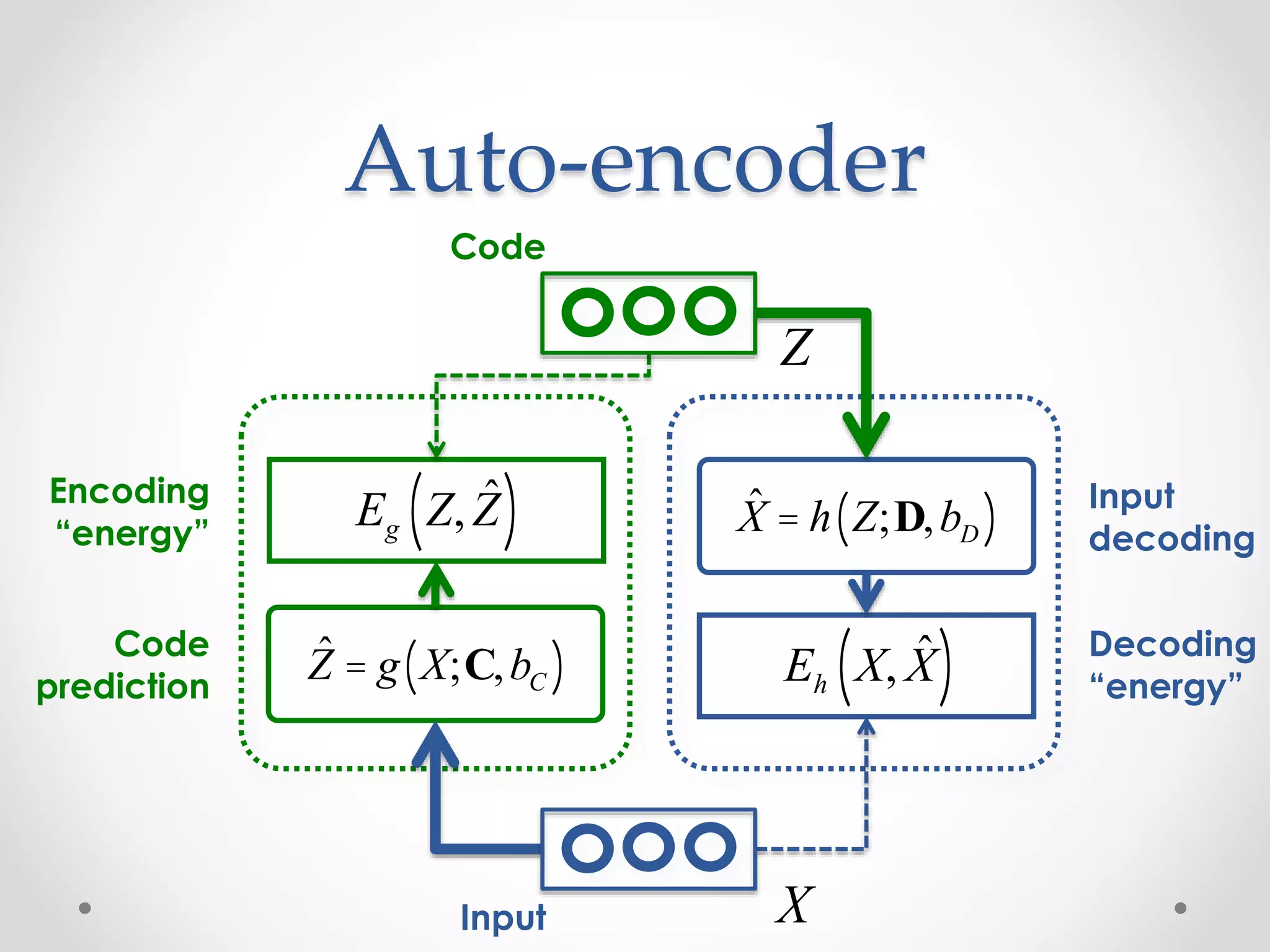
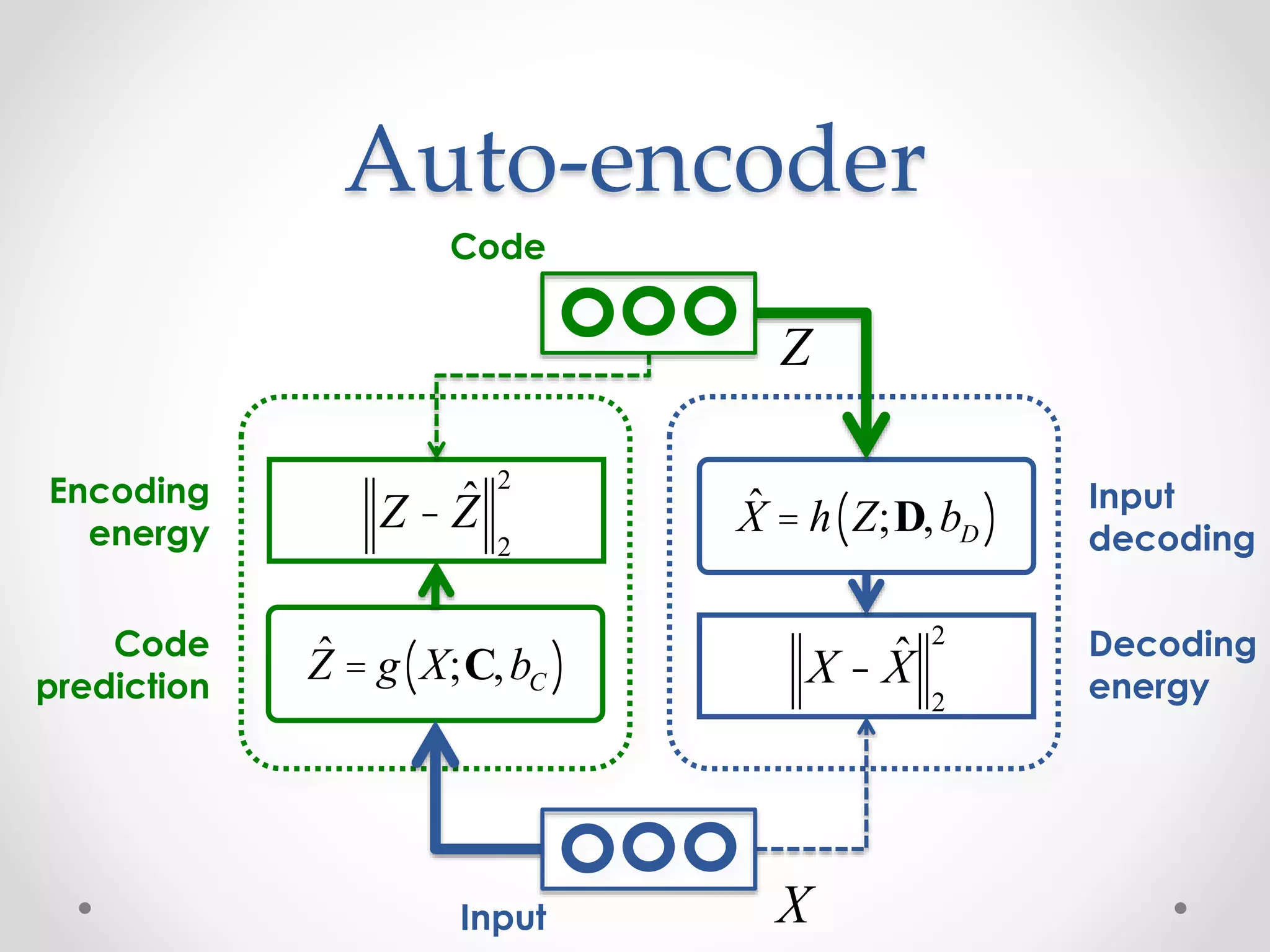
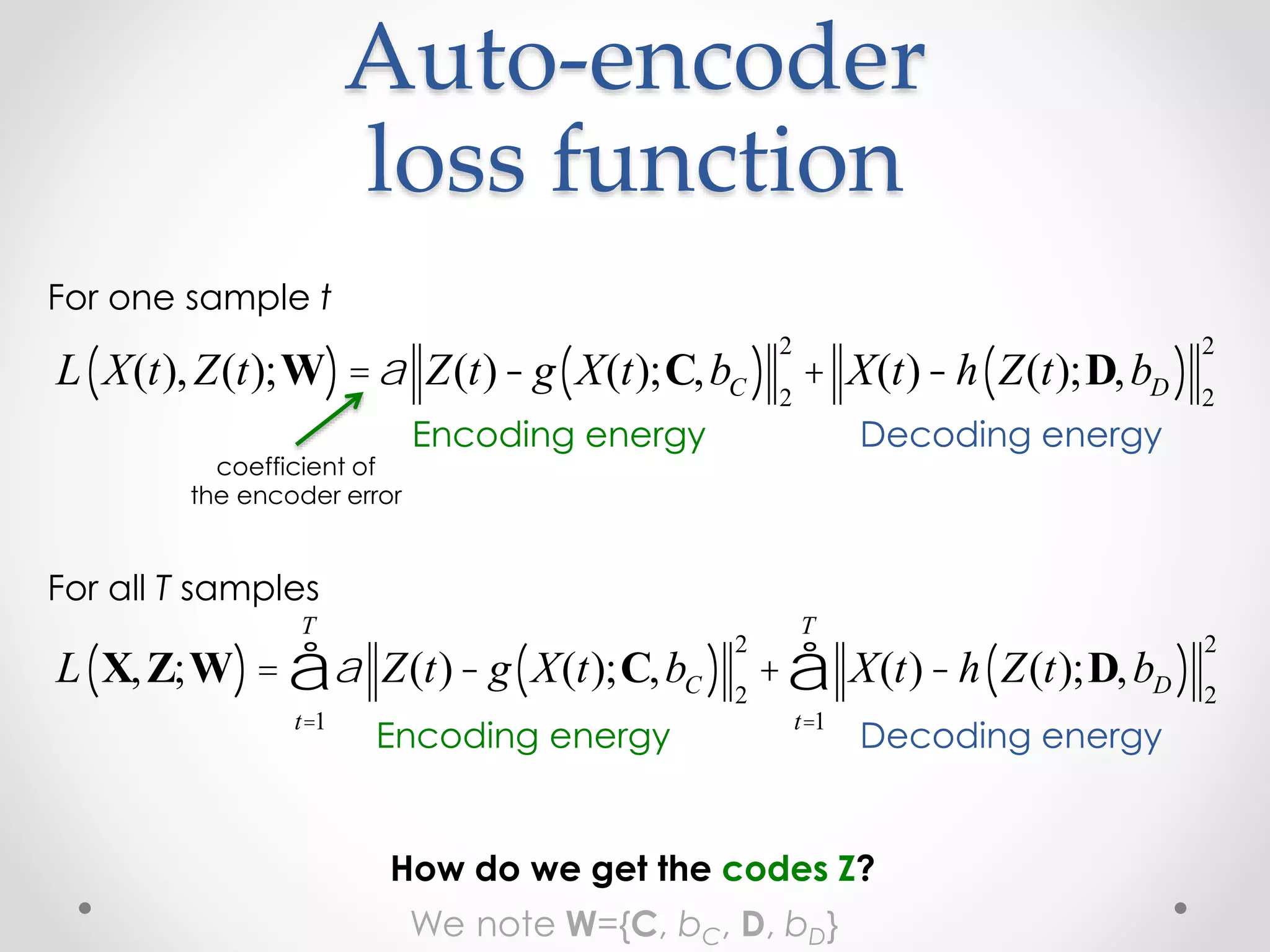

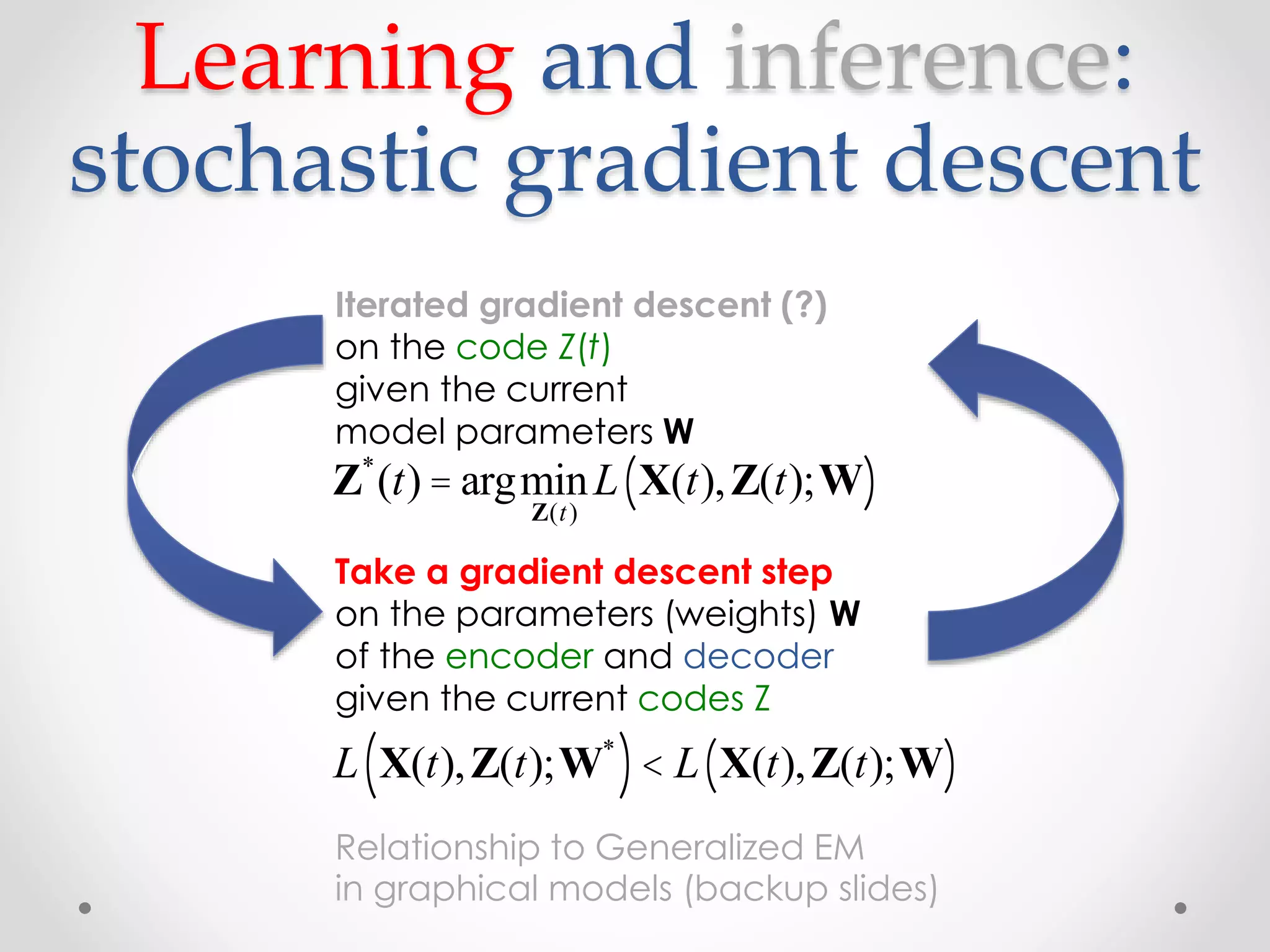
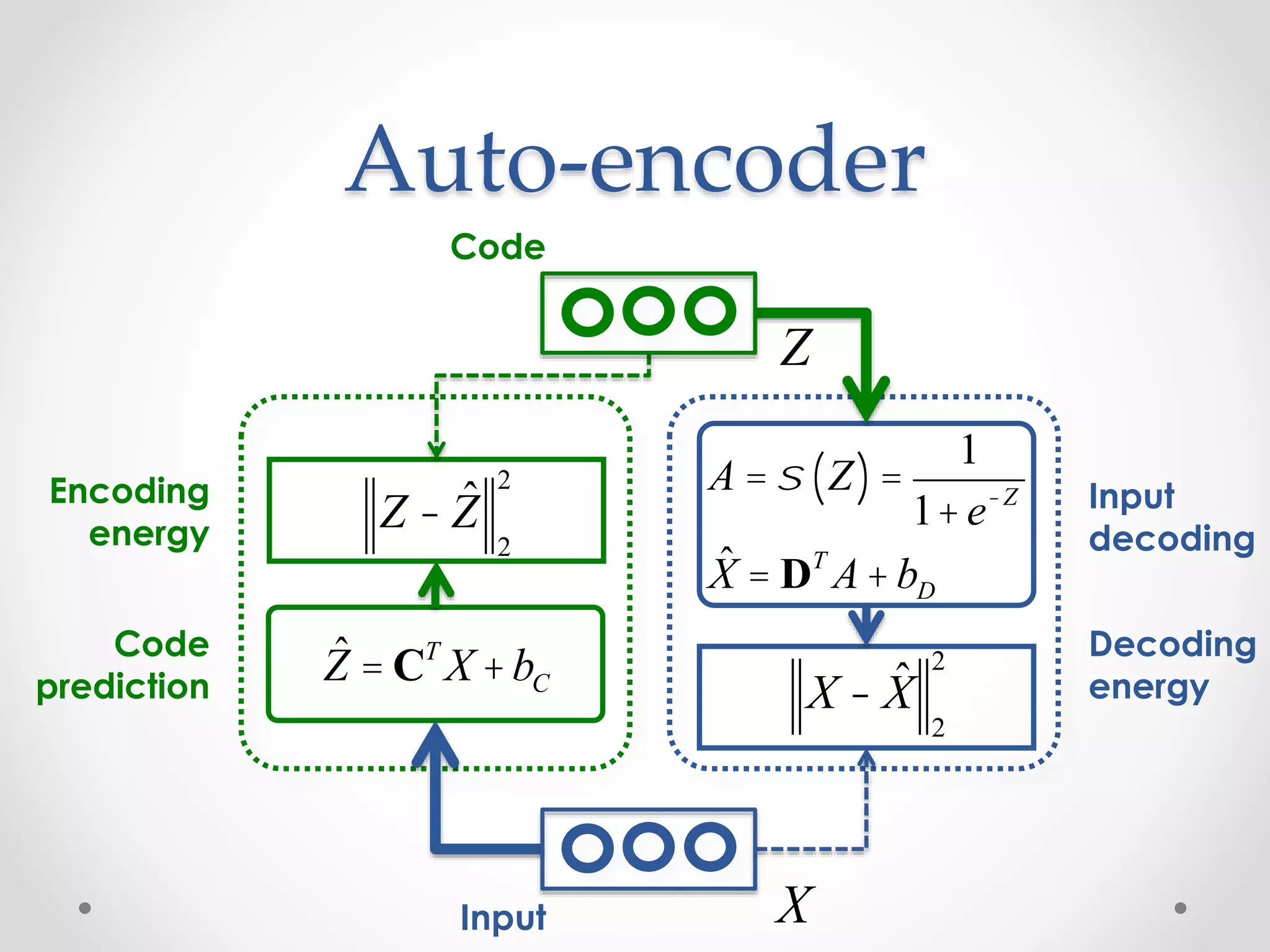
![Auto-encoder: fprop
Code
Input X
Z
function [x_hat, a_hat] = …
Module_Decode_FProp(model, z)
% Apply the logistic to the code
a_hat = 1 ./ (1 + exp(-z));
% Linear decoding
x_hat = model.D * a_hat + model.bias_D;
function z_hat = …
Module_Encode_FProp(model, x, params)
% Compute the linear encoding activation
z_hat = model.C * x + model.bias_C;
function e = Loss_Gaussian(z, z_hat)
zDiff = z_hat - z;
e = 0.5 * sum(zDiff.^2);
function e = Loss_Gaussian(x, x_hat)
xDiff = x_hat - x;
e = 0.5 * sum(xDiff.^2);](https://image.slidesharecdn.com/piotrmirowskiciunconf2014reviewautoencoders-140820024912-phpapp02/75/Piotr-Mirowski-Review-Autoencoders-Deep-Learning-CIUUK14-23-2048.jpg)
![Auto-encoder
backprop w.r.t. codes
Code
Input
Code
prediction
Encoding
energy
X
Z
¶L
¶ ˆX
=
¶
¶ ˆX
X - ˆX
2
2
( )
¶A
¶Z
=
¶s Z( )
¶Z
¶ ˆX
¶A
=
¶
¶A
DT
A + bD( )
¶Ldec
¶Z
=
¶L
¶ ˆX
¶ ˆX
¶ ˆA
¶ ˆA
¶Z
¶Lenc
¶Z
=
¶
¶Z
Z - ˆZ
2
2
( )
[Ranzato, Boureau & LeCun, “Sparse Feature Learning for Deep Belief Networks ”, NIPS, 2007]](https://image.slidesharecdn.com/piotrmirowskiciunconf2014reviewautoencoders-140820024912-phpapp02/75/Piotr-Mirowski-Review-Autoencoders-Deep-Learning-CIUUK14-24-2048.jpg)
![Auto-encoder:
backprop w.r.t. codes
Code
Z
function dL_dz = ...
Module_Decode_BackProp_Codes(model, dL_dx, a_hat)
% Gradient of the loss w.r.t. activations
dL_da = model.D' * dL_dx;
% Gradient of the loss w.r.t. latent codes
% a_hat = 1 ./ (1 + exp(-z_hat))
dL_dz = dL_da .* a_hat .* (1 - a_hat);
% Add the gradient w.r.t.
% the encoder's outputs
dL_dz = z_star - z_hat;
% Gradient of the loss w.r.t.
% the decoder prediction
dL_dx_star = x_star - x;
Input X
[Ranzato, Boureau & LeCun, “Sparse Feature Learning for Deep Belief Networks ”, NIPS, 2007]](https://image.slidesharecdn.com/piotrmirowskiciunconf2014reviewautoencoders-140820024912-phpapp02/75/Piotr-Mirowski-Review-Autoencoders-Deep-Learning-CIUUK14-25-2048.jpg)
![Code inference
in the auto-encoder
function [z_star, z_hat, loss_star, loss_hat] = Layer_Infer(model, x, params)
% Encode the current input and initialize the latent code
z_hat = Module_Encode_FProp(model, x, params);
% Decode the current latent code
[x_hat, a_hat] = Module_Decode_FProp(model, z_hat);
% Compute the current loss term due to decoding (encoding loss is 0)
loss_hat = Loss_Gaussian(x, x_hat);
% Relaxation on the latent code: loop until convergence
x_star = x_hat; a_star = a_hat; z_star = z_hat; loss_star = loss_hat;
while (true)
% Gradient of the loss function w.r.t. decoder prediction
dL_dx_star = x_star - x;
% Back-propagate the gradient of the loss onto the codes
dL_dz = Module_Decode_BackProp_Codes(model, dL_dx_star, a_star, params);
% Add the gradient w.r.t. the encoder's outputs
dL_dz = dL_dz + params.alpha_c * (z_star - z_hat);
% Perform one step of gradient descent on the codes
z_star = z_star - params.eta_z * dL_dz;
% Decode the current latent code
[x_star, a_star] = Module_Decode_FProp(model, z_star);
% Compute the current loss and convergence criteria
loss_star = Loss_Gaussian(x, x_star) + ...
params.alpha_c * Loss_Gaussian(z_star, z_hat);
% Stopping criteria
[...]
end
Code
Input
Code
prediction
Encoding
energy
X
Z
¶L
¶ ˆX
=
¶
¶ ˆX
X - ˆX
2
2
( )
¶A
¶Z
=
¶s Z( )
¶Z
¶ ˆX
¶A
=
¶
¶A
DT
A + bD( )
¶Lenc
¶Z
=
¶
¶Z
Z - ˆZ
2
2
( )
[Ranzato, Boureau & LeCun, “Sparse Feature Learning for Deep Belief Networks ”, NIPS, 2007]](https://image.slidesharecdn.com/piotrmirowskiciunconf2014reviewautoencoders-140820024912-phpapp02/75/Piotr-Mirowski-Review-Autoencoders-Deep-Learning-CIUUK14-26-2048.jpg)
![Auto-encoder
backprop w.r.t. codes
Code
Input
Code
prediction
Encoding
energy
X
Z*
¶L
¶X*
=
¶
¶X*
X - X*
2
2
( )
A*
=s Z*
( )
¶X*
¶D
=
¶
¶D
DT
A*
+ bD( )
¶L
¶D
=
¶L
¶X*
¶X*
¶D
¶L
¶Z*
=
¶
¶Z*
ˆZ - Z*
2
2
( )
[Ranzato, Boureau & LeCun, “Sparse Feature Learning for Deep Belief Networks ”, NIPS, 2007]
¶L
¶C
=
¶L
¶ ˆZ
¶ ˆZ
¶C
¶ ˆZ
¶C
=
¶
¶C
CT
X + bD( )](https://image.slidesharecdn.com/piotrmirowskiciunconf2014reviewautoencoders-140820024912-phpapp02/75/Piotr-Mirowski-Review-Autoencoders-Deep-Learning-CIUUK14-27-2048.jpg)
![Auto-encoder:
backprop w.r.t. weights
Code
Z
function model = ...
Module_Decode_BackProp_Weights(model, ...
dL_dx_star, a_star, params)
% Jacobian of the loss w.r.t. decoder matrix
model.dL_dD = dL_dx_star * a_star';
% Gradient of the loss w.r.t. decoder bias
model.dL_dbias_D = dL_dx_star;
% Gradient of the loss w.r.t. codes
dL_dz = z_hat - z_star;
% Gradient of the loss w.r.t. reconstruction
dL_dx_star = x_star - x;
Input X
[Ranzato, Boureau & LeCun, “Sparse Feature Learning for Deep Belief Networks ”, NIPS, 2007]
function model = ...
Module_Encode_BackProp_Weights(model, ...
dL_dz, x, params)
% Jacobian of the loss w.r.t. encoder matrix
model.dL_dC = dL_dz * x';
% Gradient of the loss w.r.t. encoding bias
model.dL_dbias_C = dL_dz;](https://image.slidesharecdn.com/piotrmirowskiciunconf2014reviewautoencoders-140820024912-phpapp02/75/Piotr-Mirowski-Review-Autoencoders-Deep-Learning-CIUUK14-28-2048.jpg)
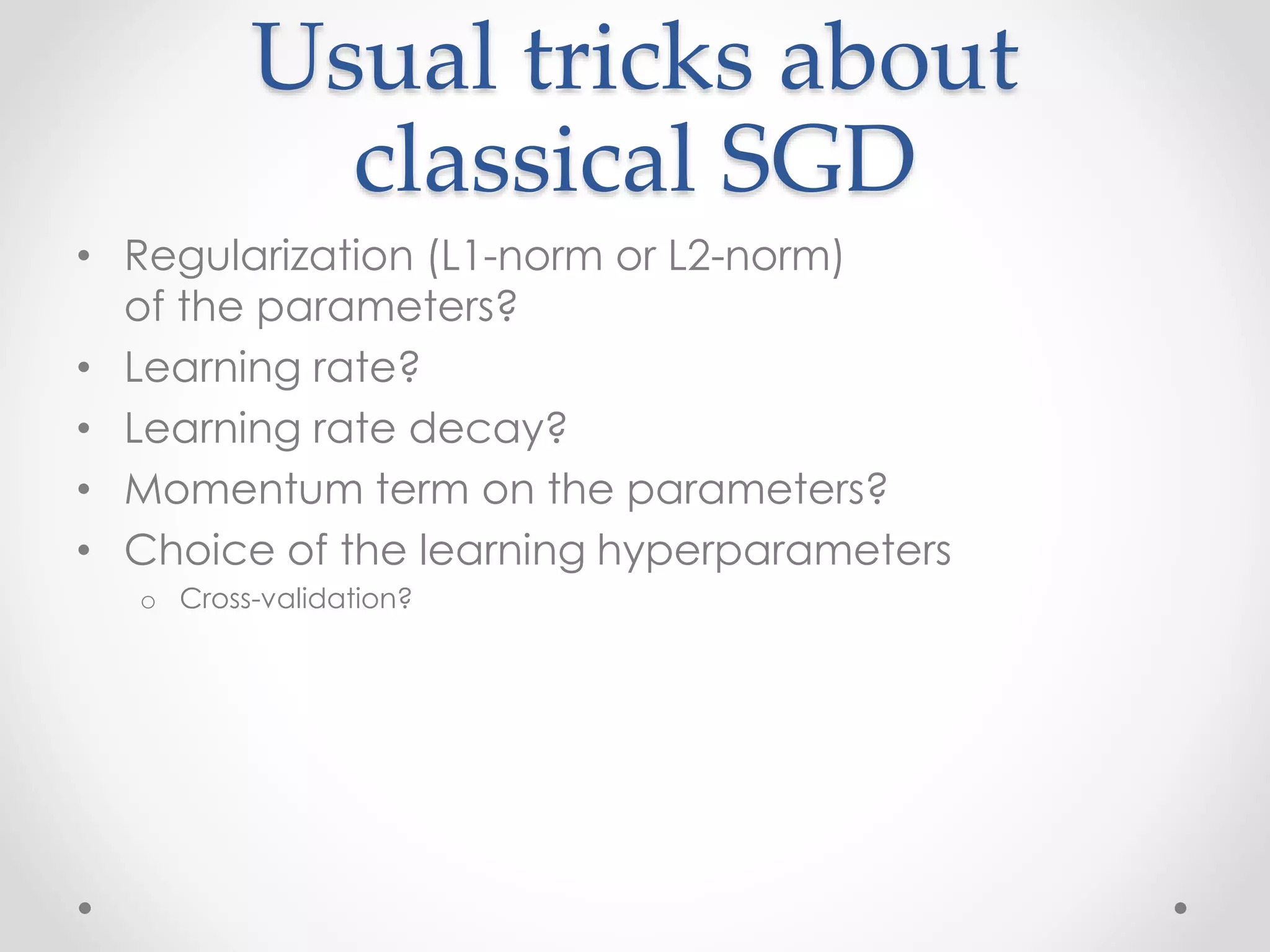
![Sparse coding
Overcomplete code
Input
Eh X, ˆX( )
ˆX = h Z;W,b( )
Decoding
error
Input
decoding
Ls Z( )
Sparsity constraint
X
Z
[Olshausen & Field, “Sparse coding with an overcomplete basis set: a strategy employed by V1? ”, Vision Research, 1997]
L X,Z;W( )=
X -h Z;W,b( ) 2
2
+ lLS Z( )](https://image.slidesharecdn.com/piotrmirowskiciunconf2014reviewautoencoders-140820024912-phpapp02/75/Piotr-Mirowski-Review-Autoencoders-Deep-Learning-CIUUK14-30-2048.jpg)
![Sparse coding
Decoding
error
Input
decoding
Sparsity constraint
Z
X - ˆX
2
2
ˆX = WT
Z +b
log 1+ zd
2
( )d=1
M
å
Input X
[Olshausen & Field, “Sparse coding with an overcomplete basis set: a strategy employed by V1? ”, Vision Research, 1997]
L X,Z;W( )=
X - WT
Z +b( ) 2
2
+lLS Z( )
Overcomplete code](https://image.slidesharecdn.com/piotrmirowskiciunconf2014reviewautoencoders-140820024912-phpapp02/75/Piotr-Mirowski-Review-Autoencoders-Deep-Learning-CIUUK14-31-2048.jpg)
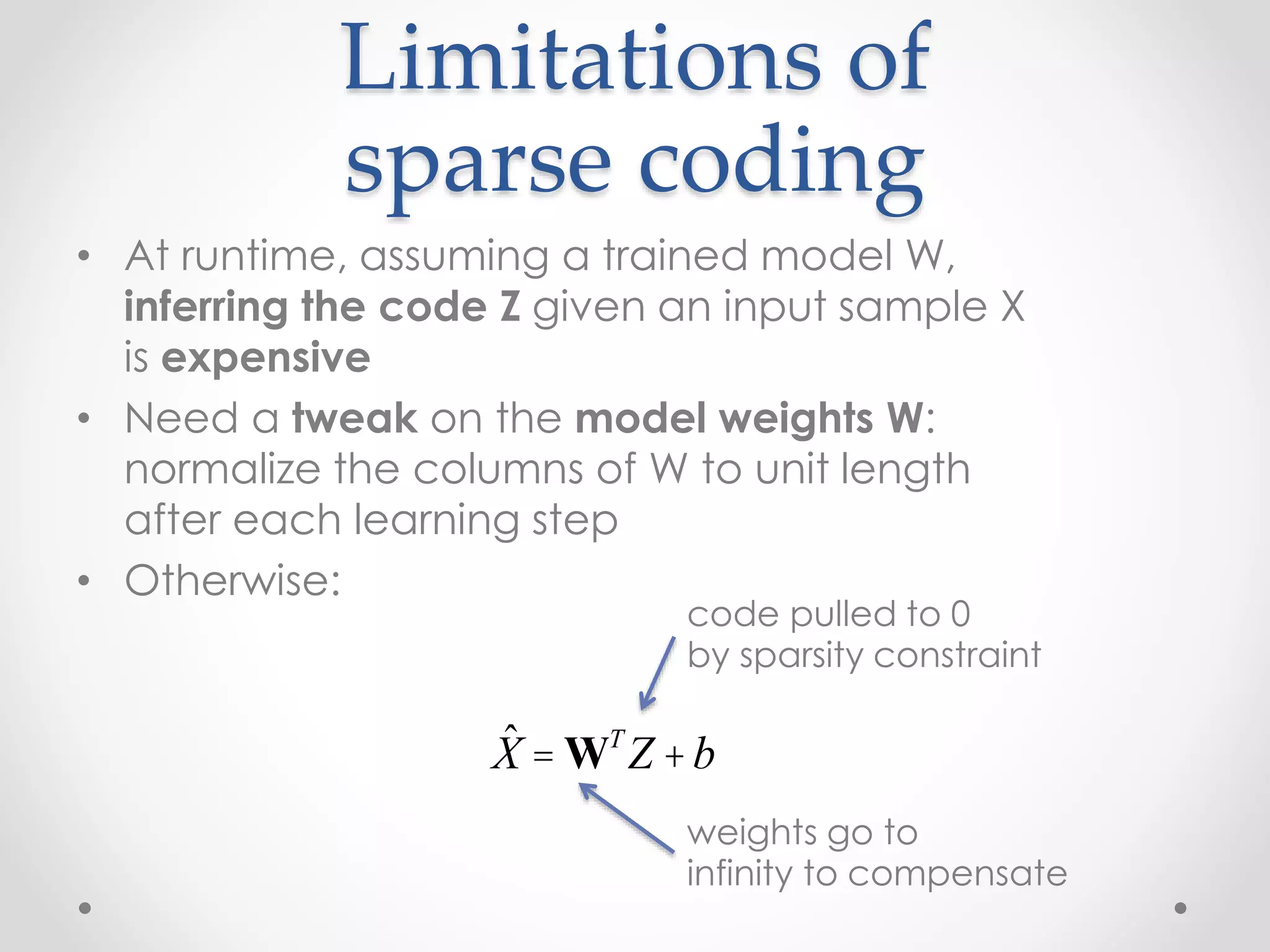
![Sparse
auto-encoder
Eg Z, ˆZ( )
Code
Input
Code
prediction
Code
error
ˆZ = g X;Wg,bg( ) Eh X, ˆX( )
ˆX = h Z;Wh,bh( )
Decoding
error
Input
decoding
Ls Z( )
Sparsity constraint
X
Z
[Ranzato, Poultney, Chopra & LeCun, “Efficient Learning of Sparse Representations with an Energy-Based Model ”, NIPS, 2006;
Ranzato, Boureau & LeCun, “Sparse Feature Learning for Deep Belief Networks ”, NIPS, 2007]](https://image.slidesharecdn.com/piotrmirowskiciunconf2014reviewautoencoders-140820024912-phpapp02/75/Piotr-Mirowski-Review-Autoencoders-Deep-Learning-CIUUK14-33-2048.jpg)
![Symmetric sparse
auto-encoder
Code
Code
prediction
Code
error
ˆZ = WX +bC
ˆX = WT
s Z( )+bD
Decoding
error
Input
decoding
Sparsity constraint
Z
Z - ˆZ
2
2
X - ˆX
2
2
log 1+s zd( )
2
( )d=1
M
å
Input X[Ranzato, Poultney, Chopra & LeCun, “Efficient Learning of Sparse Representations with an Energy-Based Model ”, NIPS, 2006;
Ranzato, Boureau & LeCun, “Sparse Feature Learning for Deep Belief Networks ”, NIPS, 2007]
Encoder matrix W
is symmetric to
decoder matrix WT](https://image.slidesharecdn.com/piotrmirowskiciunconf2014reviewautoencoders-140820024912-phpapp02/75/Piotr-Mirowski-Review-Autoencoders-Deep-Learning-CIUUK14-34-2048.jpg)
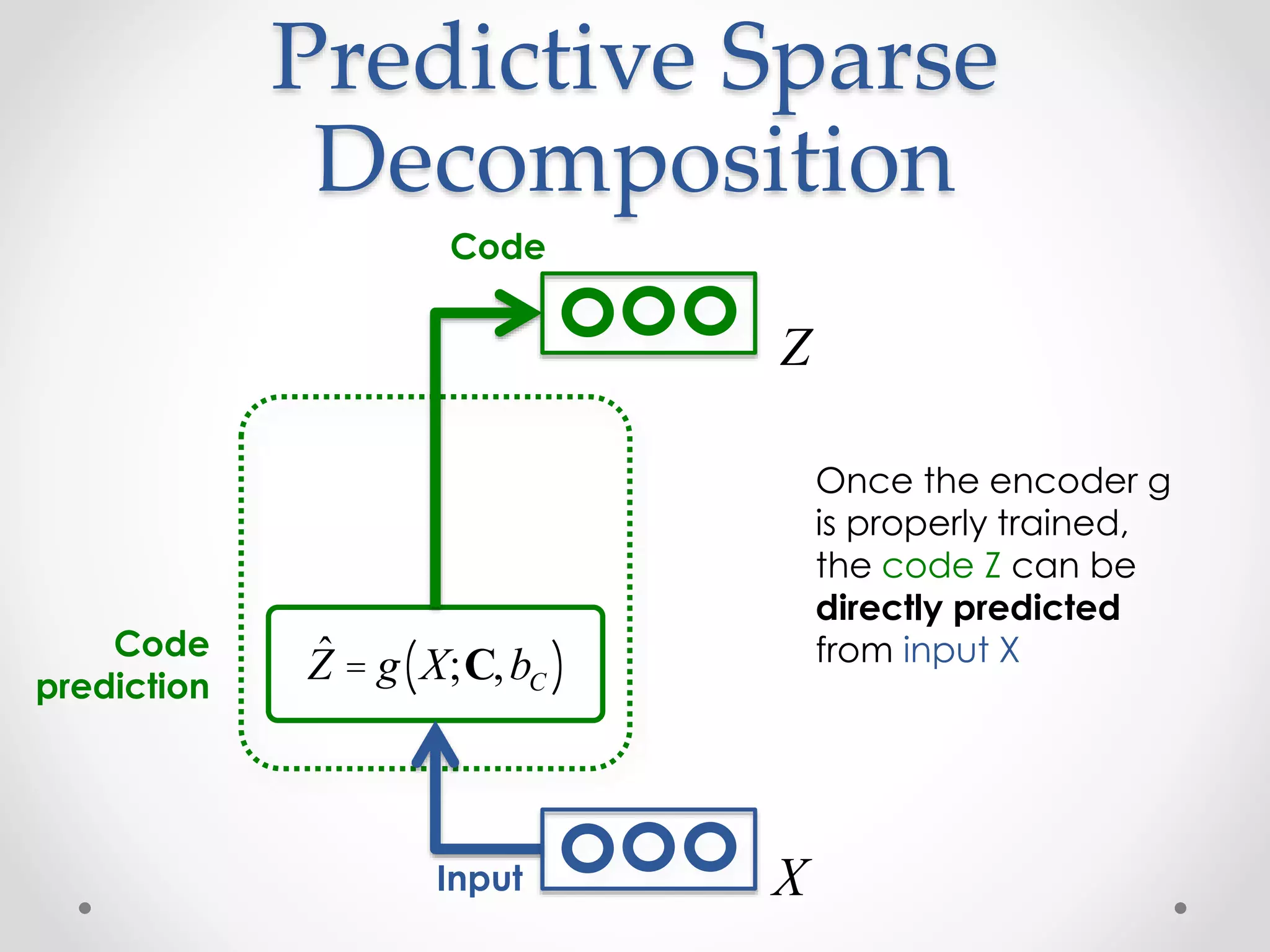
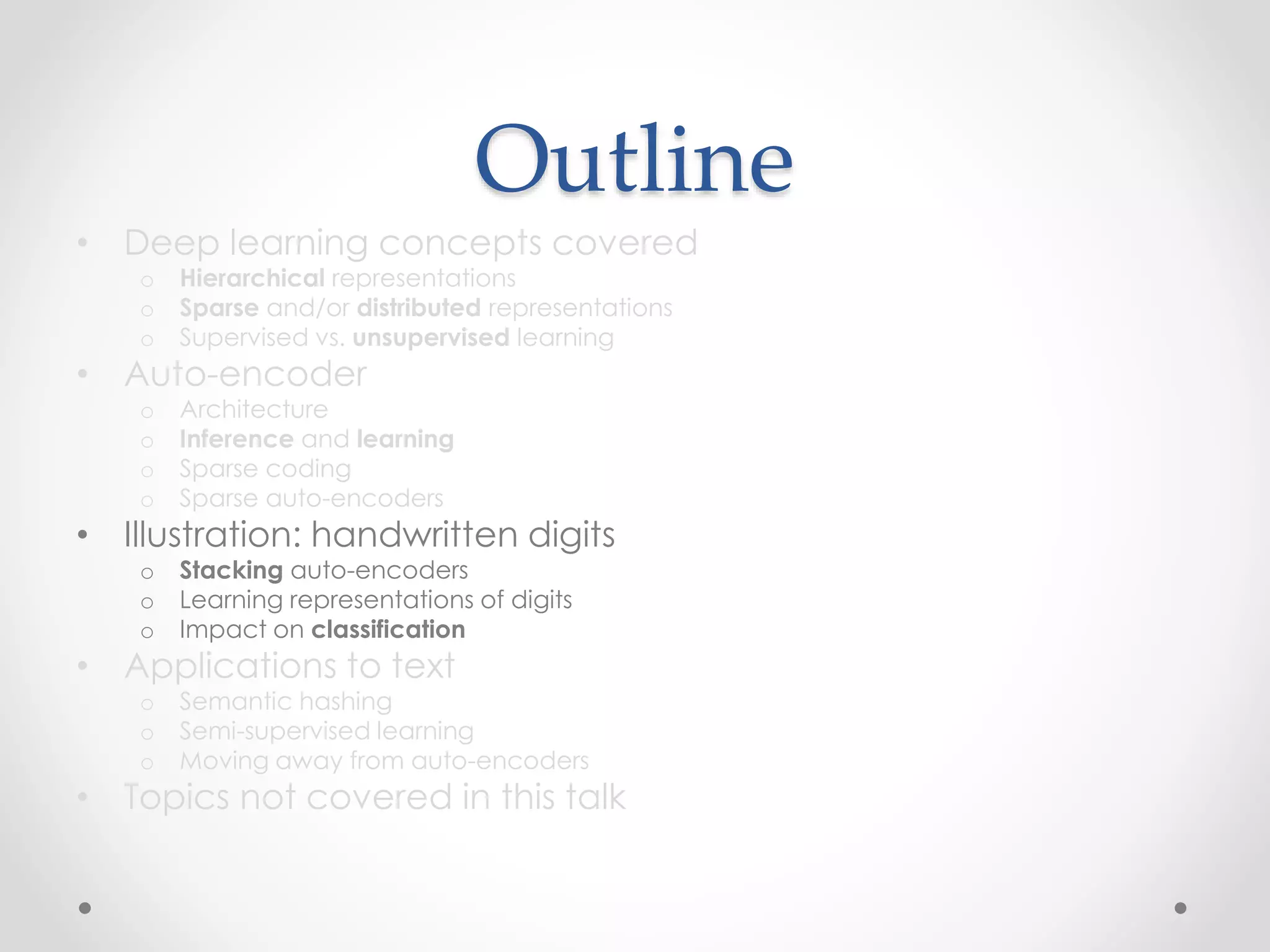
![Stacking auto-encoders
Code
Input
Code prediction
Code energy
Decoding energy
Input decoding
Sparsity
constraint
X
Z
Code
Input
Code prediction
Code energy
Decoding energy
Input decoding
Sparsity
constraint
X
Z
[Ranzato,Boureau&LeCun,“SparseFeatureLearningforDeepBeliefNetworks”,NIPS,2007]](https://image.slidesharecdn.com/piotrmirowskiciunconf2014reviewautoencoders-140820024912-phpapp02/75/Piotr-Mirowski-Review-Autoencoders-Deep-Learning-CIUUK14-37-2048.jpg)
![MNIST handwritten
digits
• Database of 70k
handwritten digits
o Training set: 60k
o Test set: 10k
• 28 x 28 pixels
• Best performing
classifiers:
o Linear classifier: 12% error
o Gaussian SVM 1.4% error
o ConvNets <1% error
[http://yann.lecun.com/exdb/mnist/]](https://image.slidesharecdn.com/piotrmirowskiciunconf2014reviewautoencoders-140820024912-phpapp02/75/Piotr-Mirowski-Review-Autoencoders-Deep-Learning-CIUUK14-38-2048.jpg)
![Stacked auto-encoders
Code
Input
Code prediction
Code energy
Decoding energy
Input decoding
Sparsity
constraint
X
Z
Code
Input
Code prediction
Code energy
Decoding energy
Input decoding
Sparsity
constraint
X
Z
Layer 1: Matrix W1 of size 192 x 784
192 sparse bases of 28 x 28 pixels
Layer 2: Matrix W2 of size 10 x 192
10 sparse bases of 192 units
[Ranzato,Boureau&LeCun,“SparseFeatureLearningforDeepBeliefNetworks”,NIPS,2007]](https://image.slidesharecdn.com/piotrmirowskiciunconf2014reviewautoencoders-140820024912-phpapp02/75/Piotr-Mirowski-Review-Autoencoders-Deep-Learning-CIUUK14-39-2048.jpg)
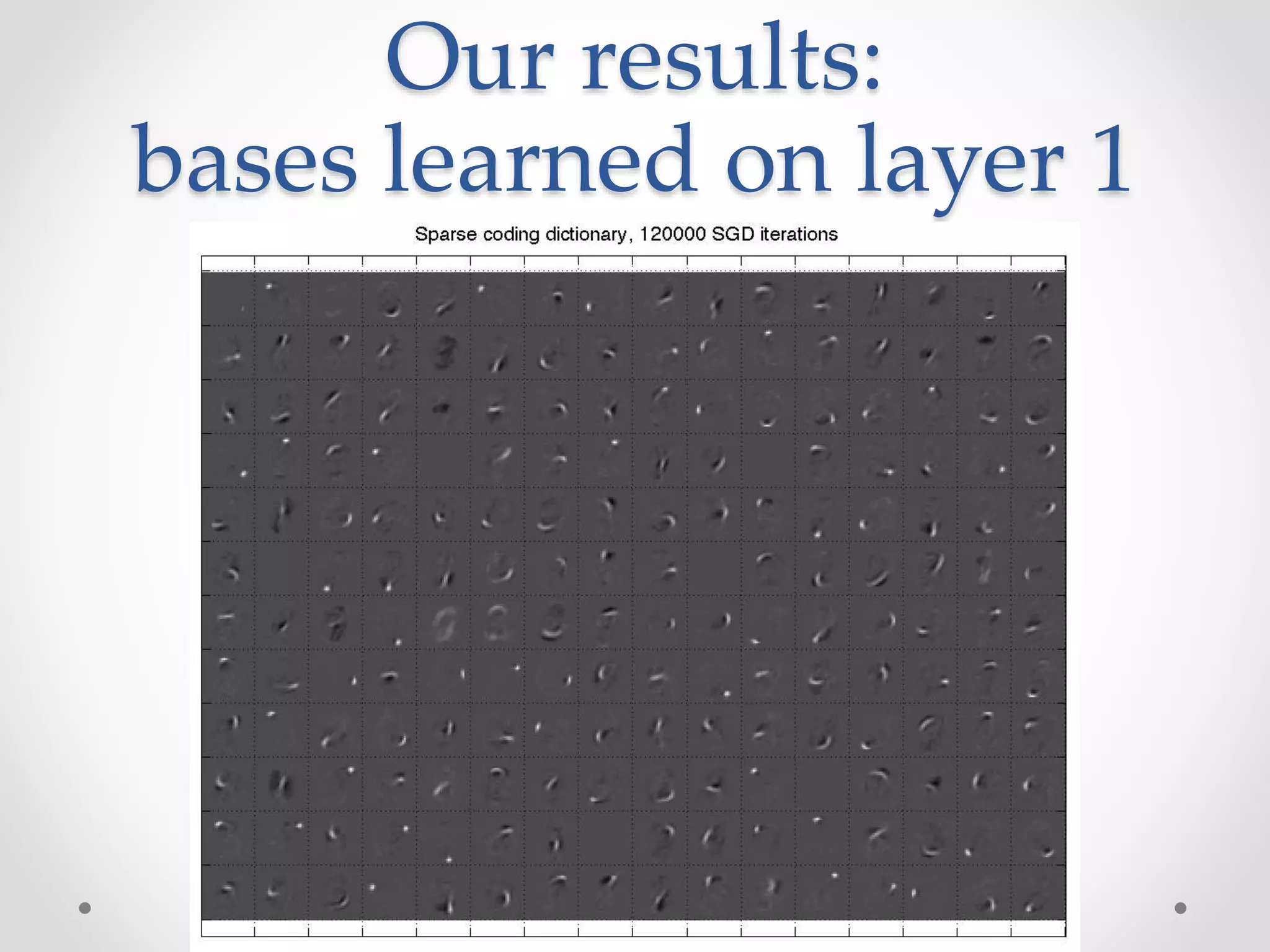
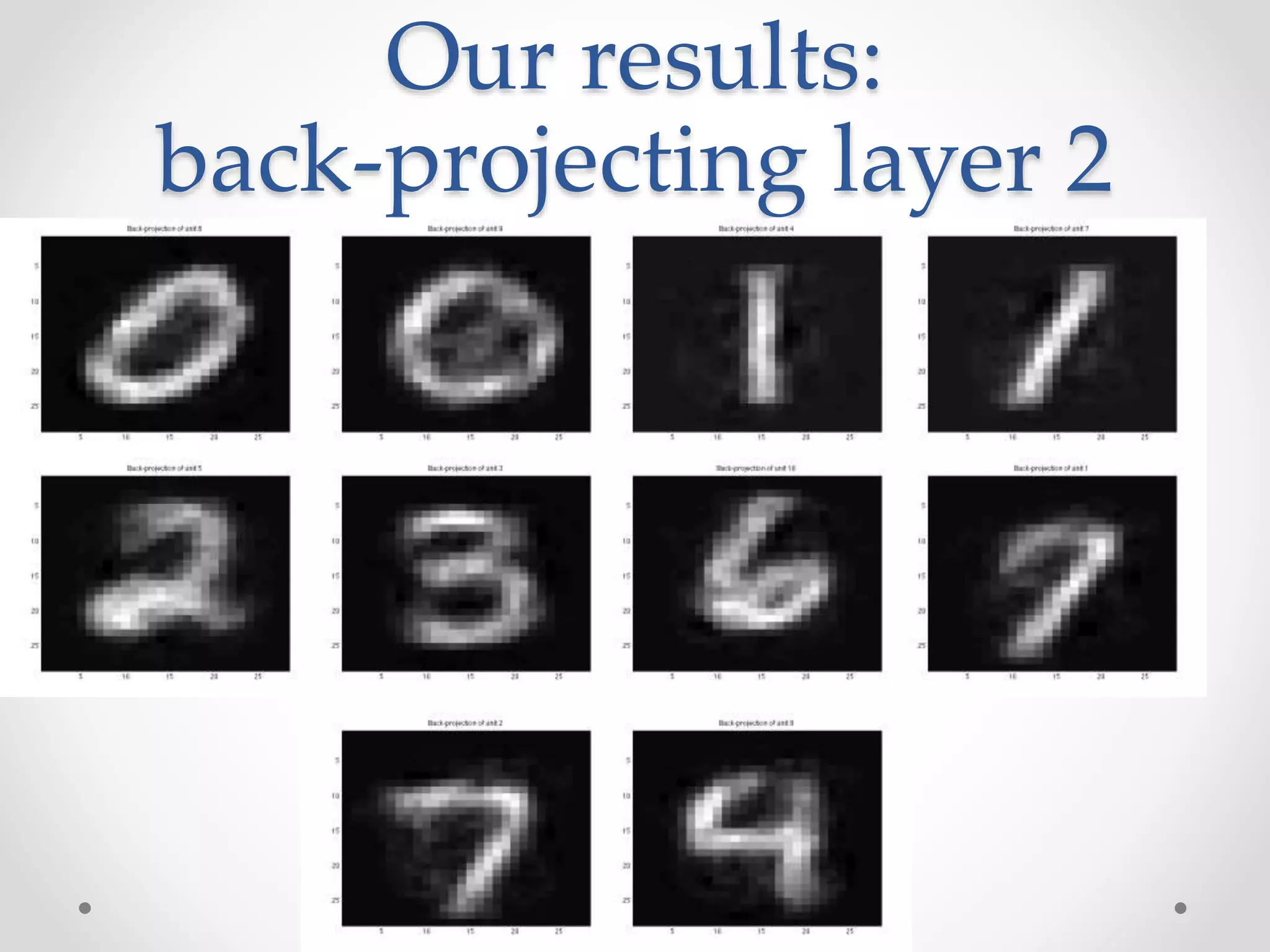
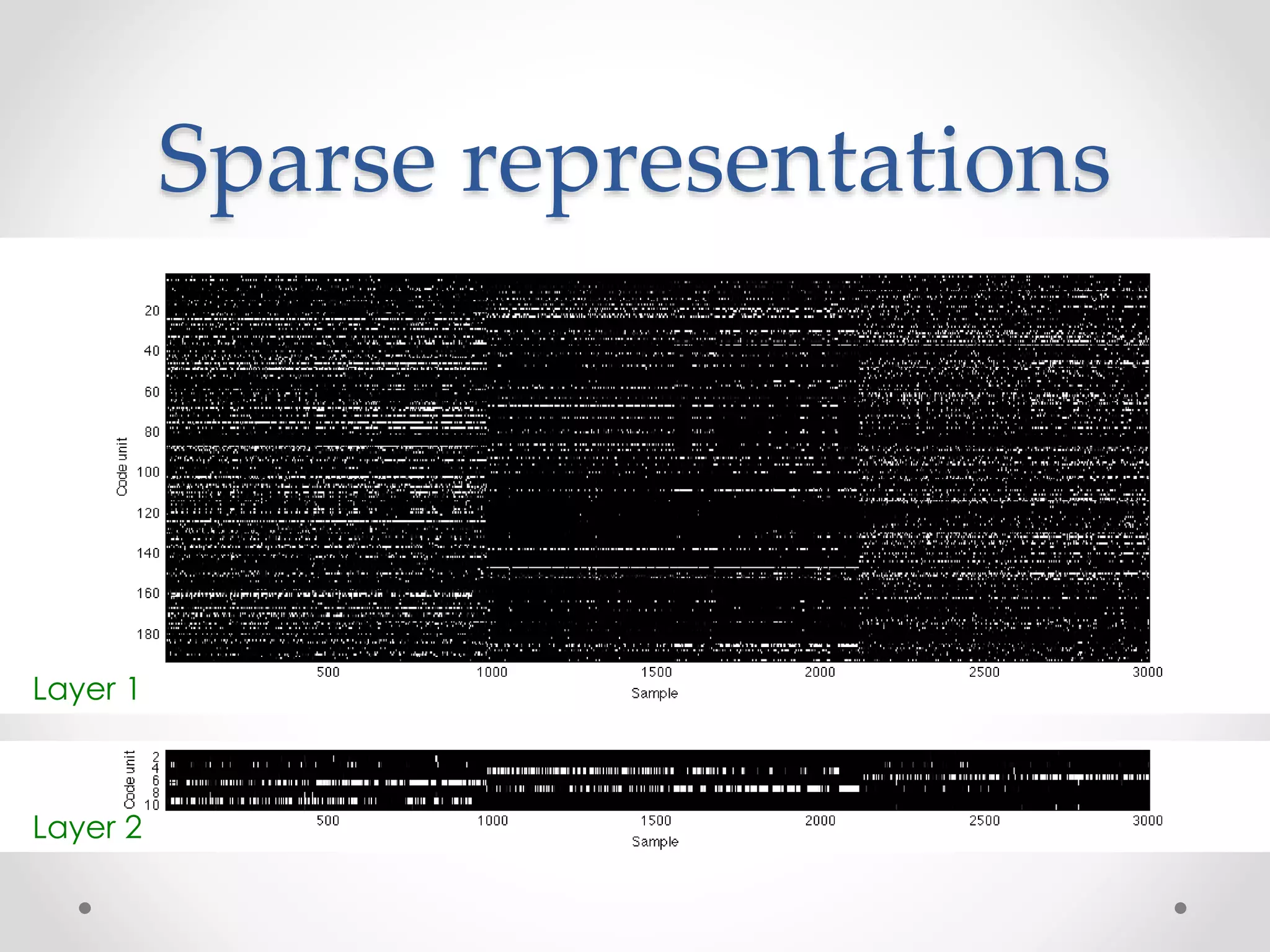
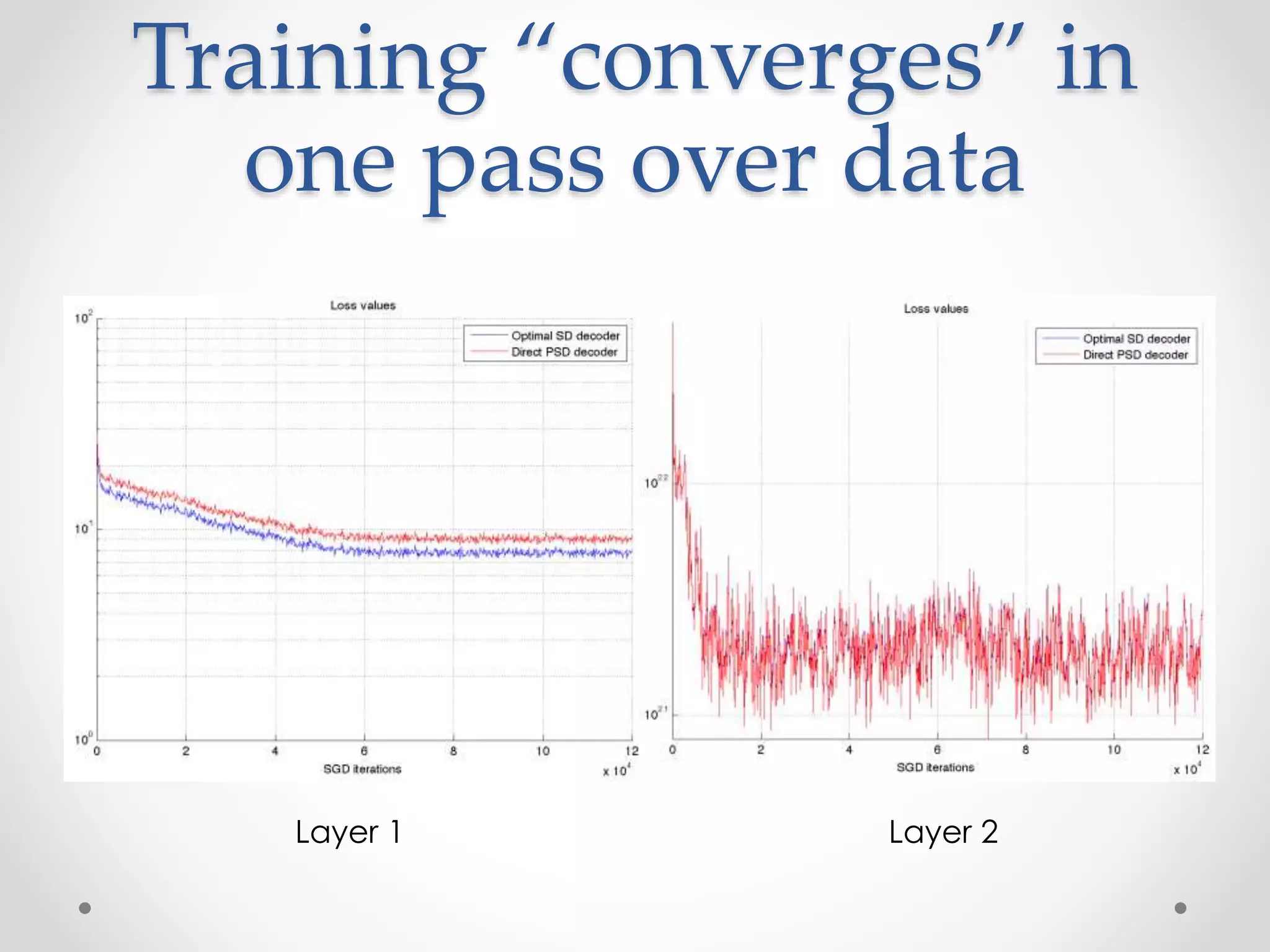
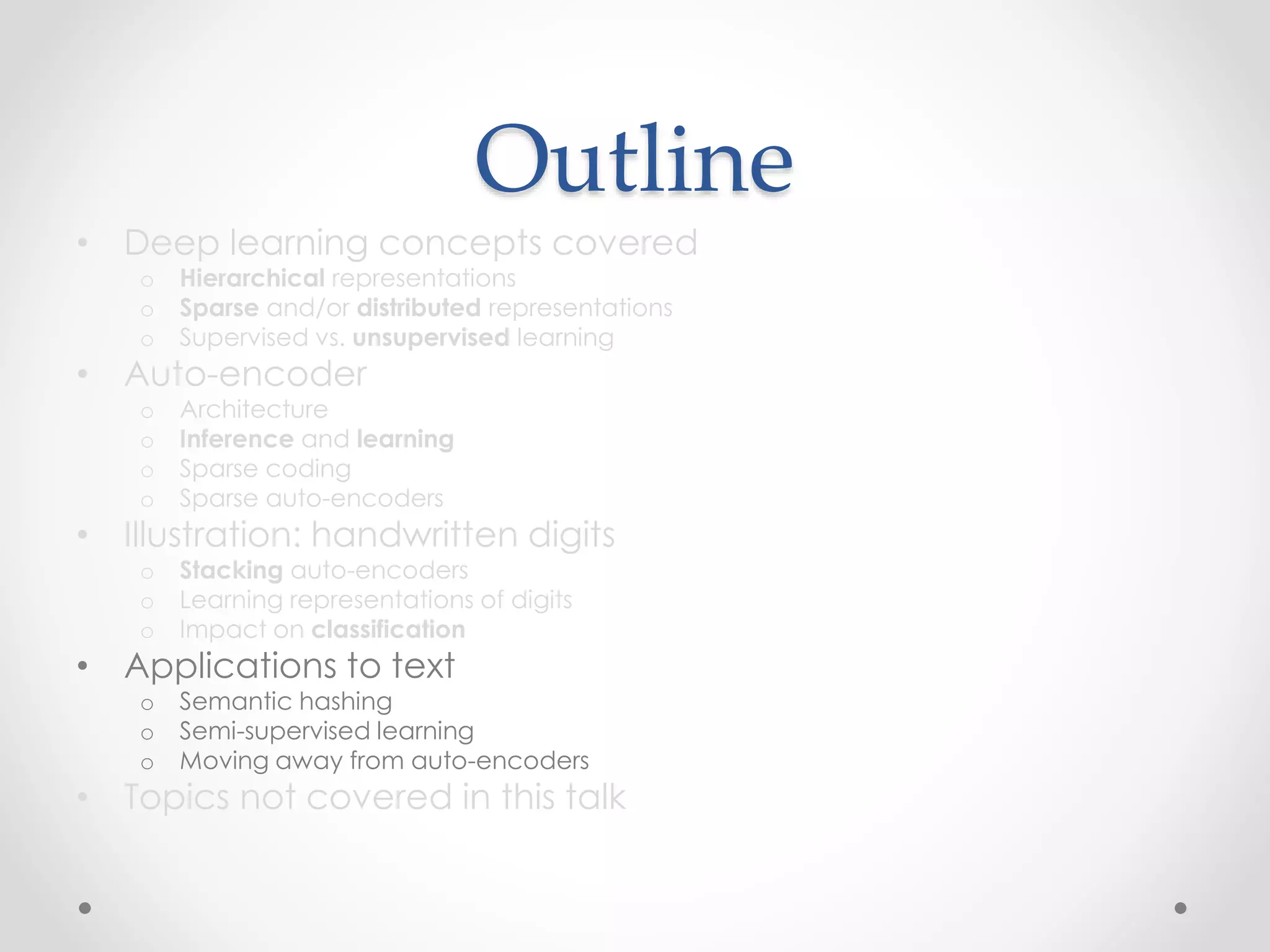
![Semantic Hashing
[Hinton & Salakhutdinov, “Reducing the dimensionality of data with neural networks, Science, 2006;
Salakhutdinov & Hinton, “Semantic Hashing”, Int J Approx Reason, 2007]
2000
500
250
125
2
125
250
500
2000](https://image.slidesharecdn.com/piotrmirowskiciunconf2014reviewautoencoders-140820024912-phpapp02/75/Piotr-Mirowski-Review-Autoencoders-Deep-Learning-CIUUK14-45-2048.jpg)
![Semi-supervised learning
of auto-encoders
• Add classifier
module to the
codes
• When a input X(t)
has a label Y(t),
back-propagate
the prediction error
on Y(t)
to the code Z(t)
• Stack the encoders
• Train layer-wise
[Ranzato & Szummer, “Semi-supervised learning of compact document representations with deep networks”, ICML, 2008;
Mirowski, Ranzato & LeCun, “Dynamic auto-encoders for semantic indexing”, NIPS Deep Learning Workshop, 2010]
y(t) y(t+1)
z(1)(t) z(1)(t+1)document
classifier f1
x(t) x(t+1)
y(t) y(t+1)
z(2)(t) z(2)(t+1)document
classifier f2
y(t) y(t+1)
z(3)(t) z(3)(t+1)document
classifier f3
auto-encoder g3,h3
auto-encoder g2,h2
auto-encoder g1,h1
Random
walk
word
histograms](https://image.slidesharecdn.com/piotrmirowskiciunconf2014reviewautoencoders-140820024912-phpapp02/75/Piotr-Mirowski-Review-Autoencoders-Deep-Learning-CIUUK14-46-2048.jpg)
![Semi-supervised learning
of auto-encoders
[Ranzato & Szummer, “Semi-supervised learning of compact document representations with deep networks”, ICML, 2008;
Mirowski, Ranzato & LeCun, “Dynamic auto-encoders for semantic indexing”, NIPS Deep Learning Workshop, 2010]
2000w-TFIDFlogistic regression F1=0.83
2000w-TFIDFSVM F1=0.84
LSA+ICA [Mirowski et al,2010] [Mirowski et al,2010] [Ranzato et al,2008]
K no dynamics L1 dynamics
100 0.81 0.86 0.85 0.85
30 0.70 0.86 0.85 0.85
10 0.40 0.86 0.85 0.84
2 0.09 0.54 0.51 0.19
Performance on document retrieval task:
Reuters-21k dataset (9.6k training, 4k test),
vocabulary 2k words, 10-class classification
Comparison with:
• unsupervised techniques
(DBN: Semantic Hashing, LSA) + SVM
• traditional technique: word TF-IDF + SVM](https://image.slidesharecdn.com/piotrmirowskiciunconf2014reviewautoencoders-140820024912-phpapp02/75/Piotr-Mirowski-Review-Autoencoders-Deep-Learning-CIUUK14-47-2048.jpg)
![Beyond auto-encoders
for web search (MSR)
[Huang, He, Gao, Deng et al, “Learning Deep Structured Semantic Models for Web Search using Clickthrough Data”, CIKM, 2013]
s: “racing car”Input word/phrase
dim = 5MBag-of-words vector
dim = 50K
d=500Letter-tri-gram
embedding matrix
Letter-tri-gram coeff.
matrix (fixed)
d=500
Semantic
vector
d=300
t1: “formula one”
dim = 5M
dim = 50K
d=500
d=500
d=300
t2: “ford model t”
dim = 5M
dim = 50K
d=500
d=500
d=300
Compute Cosine similarity
between semantic vectors cos(s,t1) cos(s,t2)
W1
W2
W3
W4](https://image.slidesharecdn.com/piotrmirowskiciunconf2014reviewautoencoders-140820024912-phpapp02/75/Piotr-Mirowski-Review-Autoencoders-Deep-Learning-CIUUK14-48-2048.jpg)
![Beyond auto-encoders
for web search (MSR)
Semantic hashing
[Salakhutdinov & Hinton, 2007]
[Huang, He, Gao, Deng et al, “Learning Deep Structured Semantic Models for Web Search using Clickthrough Data”, CIKM, 2013]
Deep Structured
Semantic Model
[Huang, He, Gao et al, 2013]
Results on a web ranking task (16k queries)
Normalized discounted cumulative gains](https://image.slidesharecdn.com/piotrmirowskiciunconf2014reviewautoencoders-140820024912-phpapp02/75/Piotr-Mirowski-Review-Autoencoders-Deep-Learning-CIUUK14-49-2048.jpg)

![Topics not covered
in this talk
• Other variations of
auto-encoders
o Restricted Boltzmann Machines
(work in Geoff Hinton’s lab)
o Denoising Auto-Encoders
(work in Yoshua Bengio’s lab)
• Invariance to shifts in
input and feature
space
o Convolutional kernels
o Sliding windows over input
o Max-pooling over codes
[LeCun, Bottou, Bengio & Haffner, “Gradient-based learning applied to document recognition”, Proceedings of IEEE,1998;
Le, Ranzato et al. "Building high-level features using large-scale unsupervised learning" ICML 2012;
Sermanet et al, “OverFeat: Integrated Recognition, Localization and Detection using Convolutional Networks”, ICLR 2014]](https://image.slidesharecdn.com/piotrmirowskiciunconf2014reviewautoencoders-140820024912-phpapp02/75/Piotr-Mirowski-Review-Autoencoders-Deep-Learning-CIUUK14-51-2048.jpg)
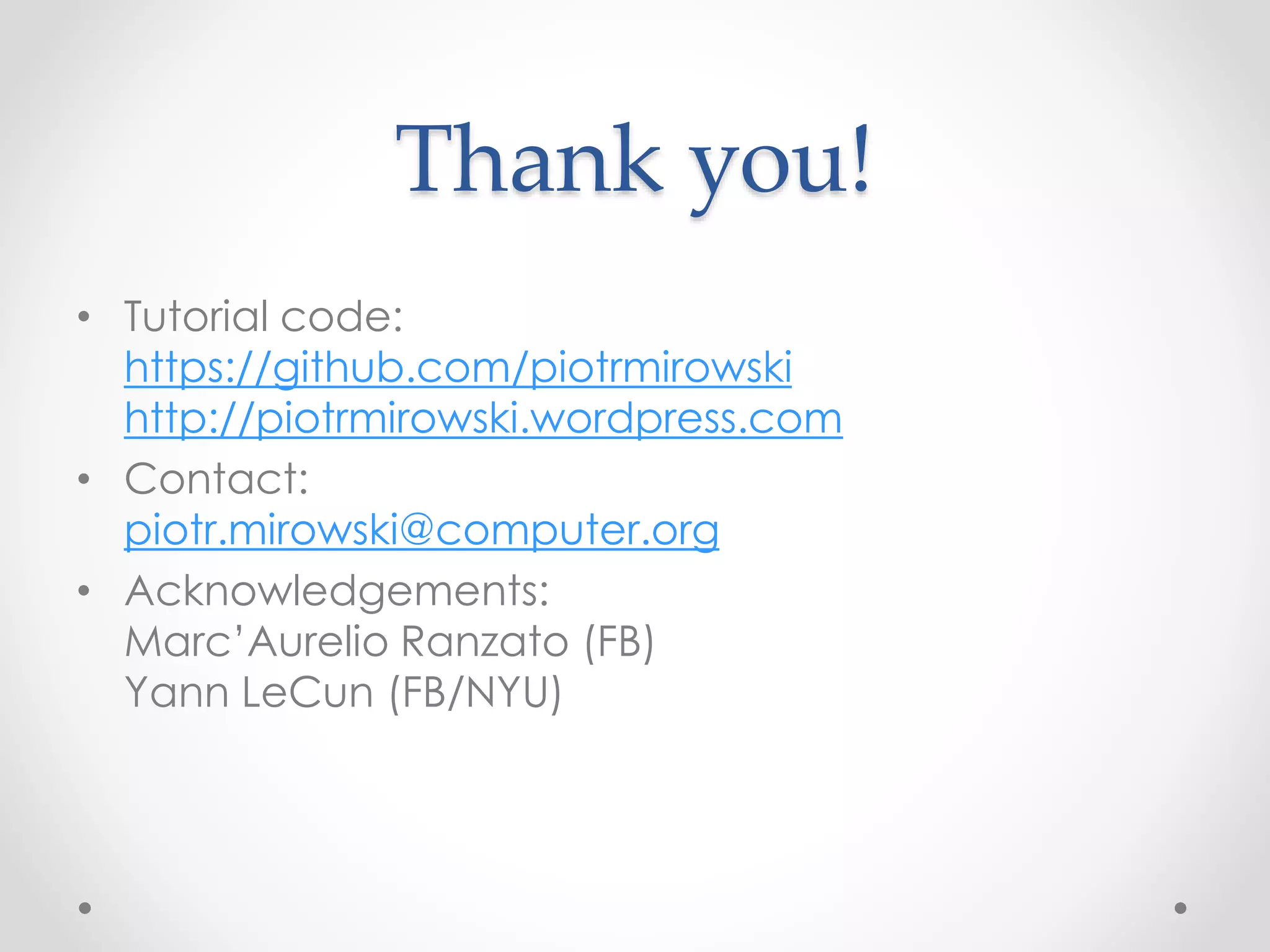
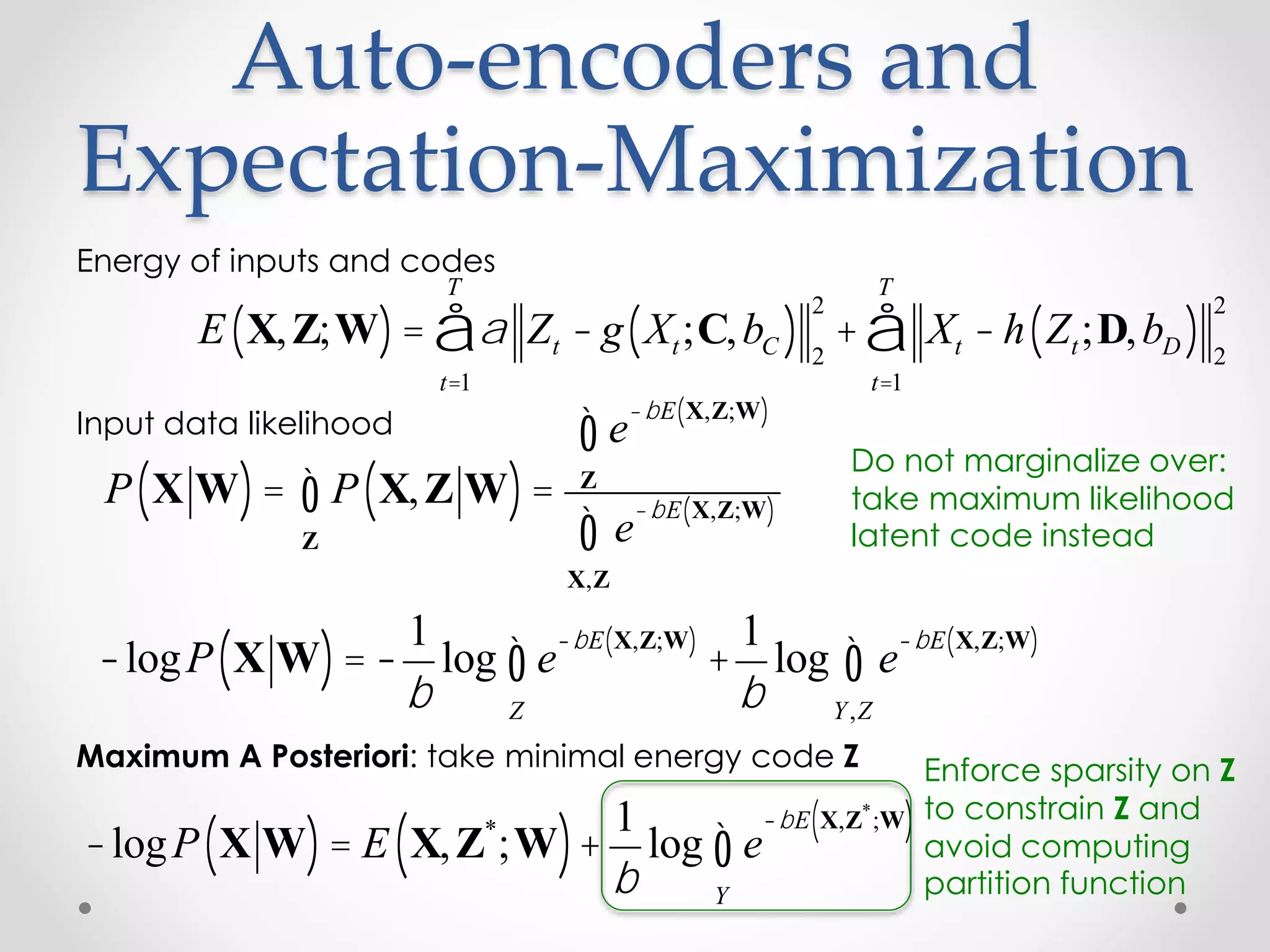
![Stochastic
gradient descent
[LeCun et al, "Efficient BackProp", Neural Networks: Tricks of the Trade, 1998;
Bottou, "Stochastic Learning", Slides from a talk in Tubingen, 2003]](https://image.slidesharecdn.com/piotrmirowskiciunconf2014reviewautoencoders-140820024912-phpapp02/75/Piotr-Mirowski-Review-Autoencoders-Deep-Learning-CIUUK14-54-2048.jpg)
![Stochastic
gradient descent
[LeCun et al, "Efficient BackProp", Neural Networks: Tricks of the Trade, 1998;
Bottou, "Stochastic Learning", Slides from a talk in Tubingen, 2003]](https://image.slidesharecdn.com/piotrmirowskiciunconf2014reviewautoencoders-140820024912-phpapp02/75/Piotr-Mirowski-Review-Autoencoders-Deep-Learning-CIUUK14-55-2048.jpg)
![Dimensionality reduction
and invariant mapping
Figure 2. Figure showing the spring system. The solid circles rep-
resent points that are similar to the point in the center. The hol-
low circles represent dissimilar points. The springs are shown as
global loss function L over all springs, one would ultimately
drive the system to its equilibrium state.
2.3. The Algorithm
The algorithm first generates the training set, then trains
the machine.
Step 1: For each input sample X i , do the following:
(a) Using prior knowledge find the set of samples
SX i
= { X j } p
j = 1, such that X j is deemed sim-
ilar to X i .
(b) Pair the sample X i with all the other training
samples and label the pairs so that:
Yi j = 0 if X j ∈ SX i
, and Yi j = 1 otherwise.
Combine all the pairs to form the labeled training set.
Step 2: Repeat until convergence:
(a) For each pair (X i , X j ) in the training set, do
i. If Yi j = 0, then update W to decrease
DW = GW (X i ) − GW (X j ) 2
ii. If Yi j = 1, then update W to increase
DW = GW (X i ) − GW (X j ) 2[Hadsell, Chopra & LeCun, “Dimensionality Reduction by Learning an Invariant Mapping”, CVPR, 2006]
Z1
Ef Z1,Z2( )
Z1 = f X1;W,b( ) Z2 = f X2;W,b( )
Z2
X1 X2
Similarly
labelled
samples
Dissimilar
codes](https://image.slidesharecdn.com/piotrmirowskiciunconf2014reviewautoencoders-140820024912-phpapp02/75/Piotr-Mirowski-Review-Autoencoders-Deep-Learning-CIUUK14-56-2048.jpg)